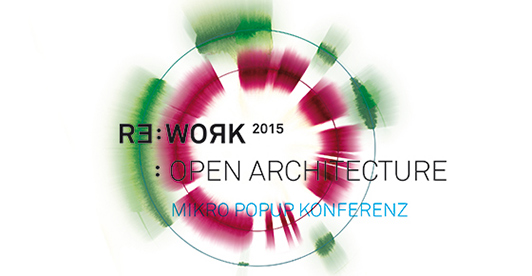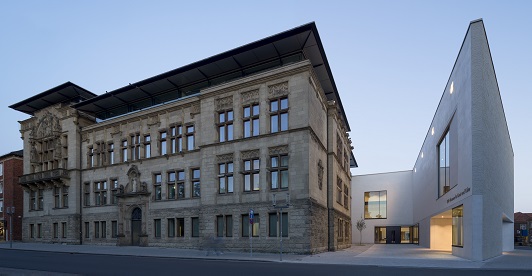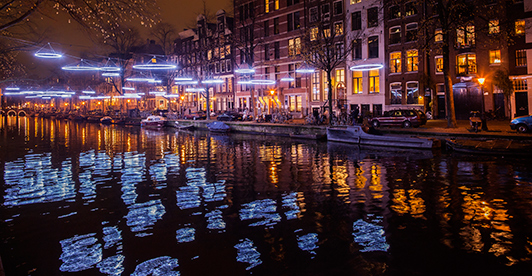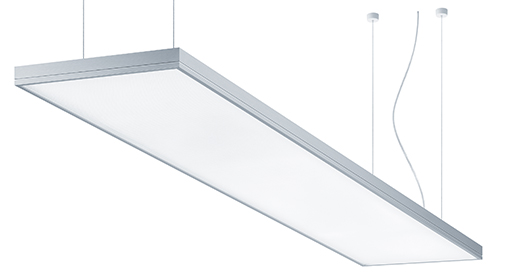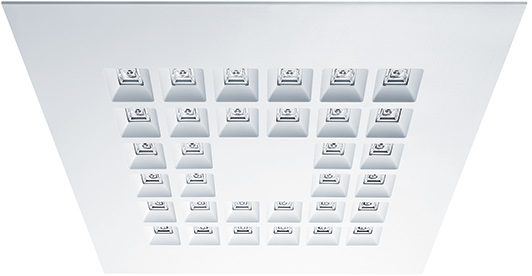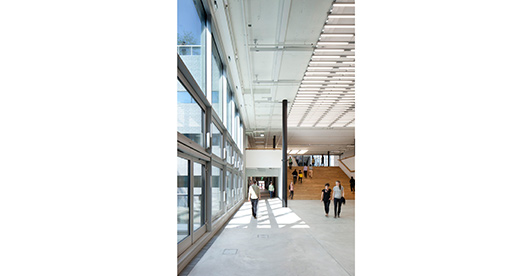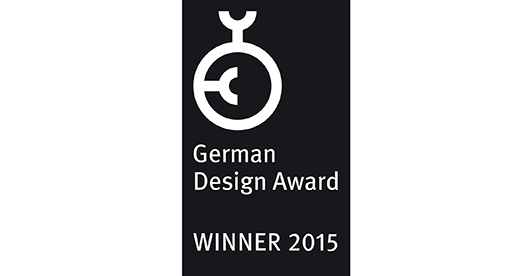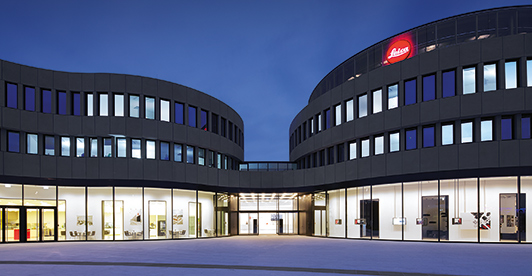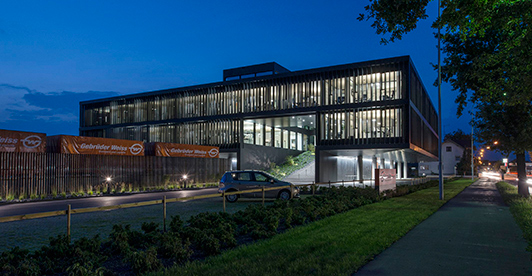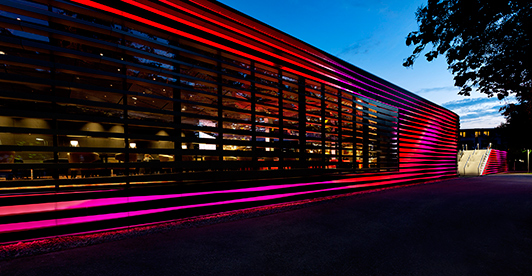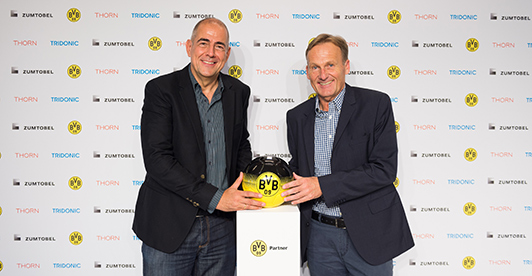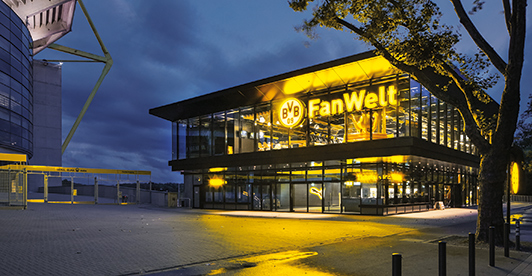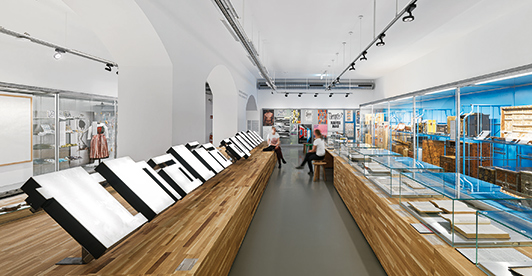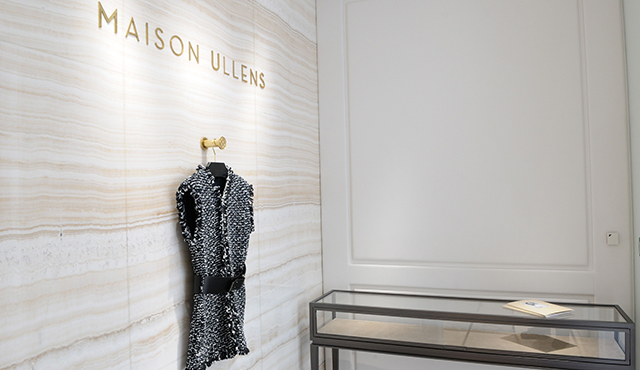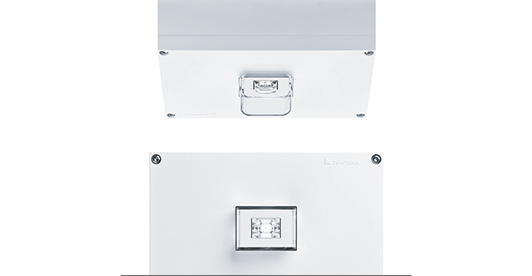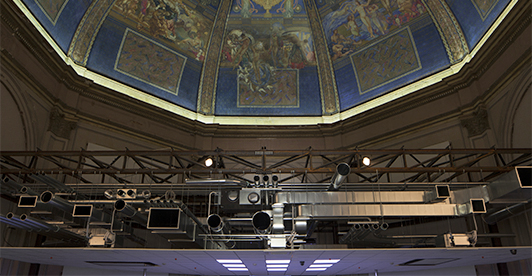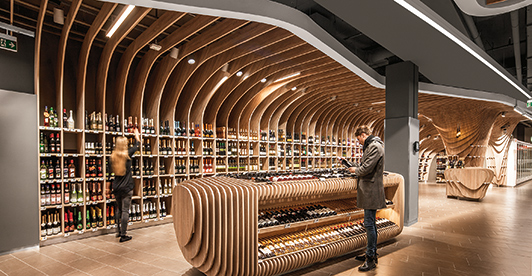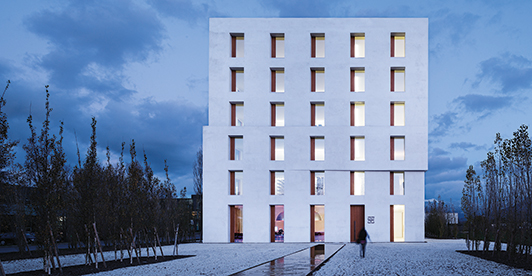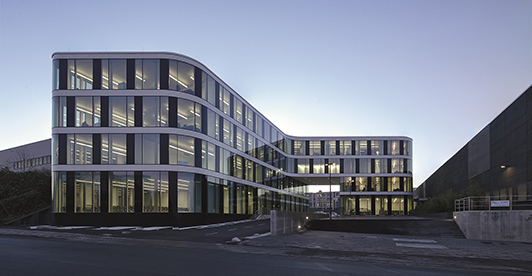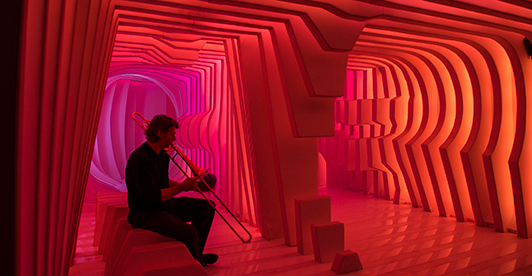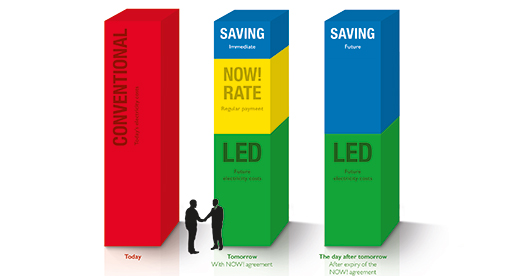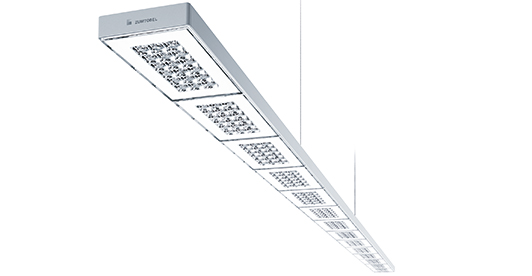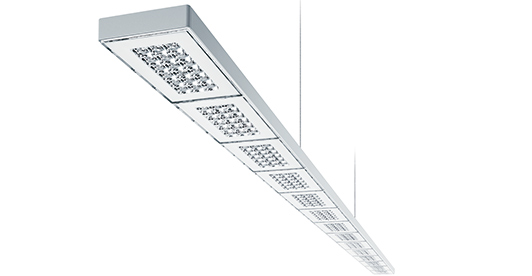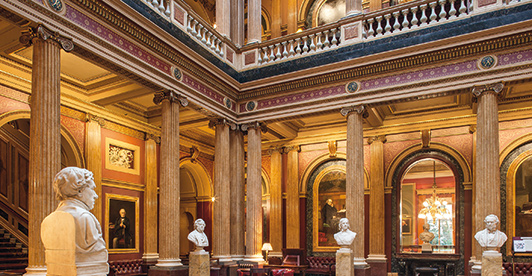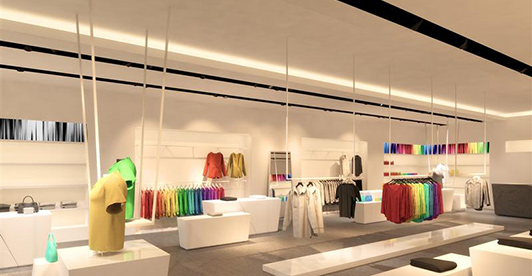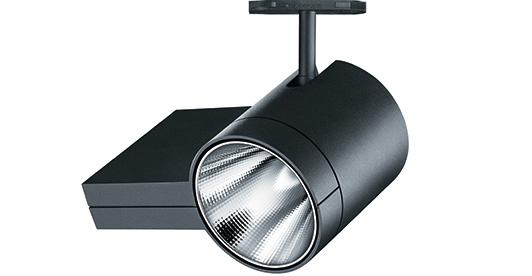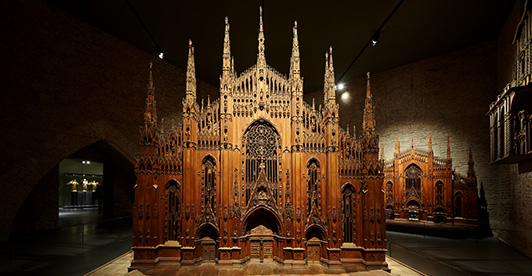Press Contact
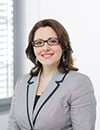
Head of Brand Marketing Zumtobel
Tel.: +49 170 3385 222
[email protected]
Press information 2014
-
12/2014Event
Zumtobel launches new RE:WORK platform for architects
RE:WORK ist eine neue Plattform für Office-Architektur von Zumtobel. Konzipiert als Pop-up-Konferenz schlägt RE:WORK seine Zelte dort auf, wo Architektur entsteht – in Kooperation mit unterschiedlichen Architekturbüros in Deutschland und Europa.More informationLess information
RE:WORK is a brand new platform from Zumtobel for office architecture. Designed as a pop-up conference, RE:WORK sets up camp exactly where architecture is created, in cooperation with various architecture design studios across Germany and Europe. The focus is on building new networks and enabling personal exchanges with colleagues and experts on topical architectural issues that help deliver practical benefits. The theme for 2015 is Open Source Architecture, as participants examine the real challenges and opportunities of networked, open architecture concepts.
At the opening event in Berlin on 29. January 2015, Beatrice Galilee from » Metropolitan Museum New York will offer a glimpse behind the scenes of the » WikiHouse Open Source construction platform. In addition, Verena von Beckerath from Berlin architects Heide & von Beckerath will talk about her experience with participative processes in building projects.
RE:WORK will then travel to Hamburg, Stuttgart, Munich, Frankfurt, Leipzig and Cologne with a range of national and international speakers, including Anna Heringer from Linz and product designer Assa Ashuach from London. The presentations will also be made available to a wider audience on the dedicated zumtobel.de/rework microsite.
The micro-conferences will be accompanied by an exhibition and a special publication showcasing 64 international projects that have been specially compiled by a team of young architecture curators. A mobile kitchen will serve Open Source refreshments.
Registration
Opening event: 29. January, 18:00 (until 21:00) Venue: Lehrter 17, Lehrterstr. 17, 3te Etage HH, 10557 Berlin
Registration and further information:
Zumtobel. The light.
-
share it
-
-
12/2014Lighting Solution
Light through the ages
The multifunctional SUPERSYSTEM forms a unifying light element in the successful renovation of the listed arcades at the LWL Museum in the city of Muenster, Germany.More informationLess informationEleven years in the planning, five years in the making – a combination of brand new construction and renovation of the existing building dating from 1908 has transformed the » LWL-Museum of Art and Culture in Muenster into one of the biggest art museums in Germany. In many ways, the architecture can be seen to reflect the 1,000 years of art on display. Old and new are merged into a single architectural unit to showcase works from the Middle Ages to modern times, ensuring a unique visitor experience. "Art needs daylight," explains Museum Director Hermann Arnhold. This principle applies not only to the new construction, but also to the historic parts of the building, where a spacious atrium is surrounded on two levels by an arcade. It was therefore necessary to design a new lighting solution for these officially protected arcades as part of the refurbishment.
Looking at how the arcades are currently used helped identify the key requirements. Flexibility and adaptability are extremely important factors for both temporary exhibitions and the correct presentation of a wide range of sculptures and objects. The integration of the lighting solution into the existing structures also played a major role, with visual disturbance caused by additional elements to be kept to an absolute minimum in the historical rooms. In addition, as the architecture offers visitors fine views across the central courtyard, it was necessary to find a suitable holistic lighting solution for both levels of the arcade.
After several test installations and close cooperation with the local listed buildings authority, lighting designer » Licht Kunst Licht AG from Bonn opted for » SUPERSYSTEM from Zumtobel. Given the combination of minimalist form, versatility and excellent lighting quality for sensitive artworks, this understated lighting system offered the perfect solution. When suspended centrally in line with the top of the columns, SUPERSYSTEM is the unifying light element that runs through the historic arcades.
SUPERSYSTEM performs several functions. It provides uniform indirect illumination of the vaulted areas for diffuse general lighting, carefully avoiding the transverse arches and only highlighting the vaults. In addition, fixed LED mini-spots enable direct lighting when required. The beam angle can be adapted for specific exhibitions by changing the lenses in the adjustable SUPERSYSTEM heads. Thanks to the flexibility of the light system, spotlights used elsewhere in the museum can also be mounted on the track to accentuate particular exhibits. The DALI lighting controls system works in combination with a portable control panel, making it easy for staff to independently regulate the direct and indirect lighting and individually adjust every group of LED mini-spots.
Zumtobel. The light.
-
share it
-
-
11/2014Event
Zumtobel partners with Amsterdam Light Festival
Zumtobel supports major lighting projects of the 3rd Amsterdam Light Festival
Starting on 27. November 2014, the Amsterdam Light Festival will be illuminating the Dutch capital this winter. The boat tour Water Colors opens with artworks by Jacques Rival, Angus Muir, Alaa Minawi and other artists. In addition, from 11. December, a collection of 15 artworks will light up the walking tour “Illuminade” in the Plantage district of the city. A total of 40 installations will transform Amsterdam into a truly spectacular winter festival. Zumtobel is supporting the Amsterdam Light Festival as main sponsor, whilst also helping to realize two major art projects at the event.More informationLess information» The Jury is made up of a panel of art experts and enthusiasts who judged a varied selection of works. Most pieces have been specially created for the » Amsterdam Light Festival and have never previously been exhibited. The city will be awash with light sculptures, projections and installations by contemporary local and international artists. The boat route, “Water Colors”, will take visitors past artworks along the Amstel and the city’s famous network of canals. The walking route, “Illuminade”, winds through the city center. Light will play a central role throughoutthe city during the festival, as museums and institutions organize light-related activities and treat visitors to some of the latest innovations in the world of light art.
The theme for the festival, ‘A Bright City’, challenges artists to create a tribute to modern Amsterdam. The resulting artworks will present a unique take on contemporary urban life in the Dutch capital. The Austrian lighting solutions partner Zumtobel is acting as a key partner for the realization of central artworks at the Amsterdam Light Festival by providing advice and lighting solutions developed specifically for the event. As well as sponsoring the whole festival, Zumtobel is also helping to realize two major installations: INTREPID, The Paper Boat by Katja Galyuk/City+Light and Re(bi)cycle Dome by Vasili Popov.
“By partnering with the Amsterdam Light Festival, we are fostering our strong engagement with light and art,” says Stefan von Terzi, Marketing Director at Zumtobel. “We are looking forward to taking part in one of the largest light festivals in Europe, supporting artists and designers both with our lighting solutions and our experience.”
Zumtobel to open LightLab in Amsterdam
On 16. January 2015, Zumtobel will officially open a brand new creative design center in the city of Amsterdam. The opening will be accompanied by the first ever exhibition of their renowned Masterpieces Collection, containing unique light sculptures by Zahad Hadid, Olafur Eliasson and Daniel Libeskind. The Masterpieces Collection will be then on show to the public at the well-known Amsterdam Center for Architecture (ARCAM) until the middle of March 2015.
About Amsterdam Light Festival
Amsterdam Light Festival is the winter light festival for everyone, regardless of age. The historic city center of Amsterdam is the atmospheric backdrop of the light and water festival lasting more than 50 winter days. The festival shows light sculptures and projections of contemporary (international) artists in public space. Amsterdam Light Festival brings light during the darkest period of the year and illuminates the audience with colorful artworks.» http://www.amsterdamlightfestival.com/
Photo Credits: © Janus van den Eijnden
Zumtobel. The Light.
-
share it
-
-
11/2014Products
LED lighting solutions meeting individual needs
A global user study conducted by Zumtobel and Fraunhofer IAO has shown that office users prefer colour temperatures in the range between 3000 K and 6000 K. Against this background, Zumtobel has added tunableWhite technology to its range of office luminaires.More informationLess informationThe » global user study on lighting quality perceived in offices conducted by Zumtobel and » Fraunhofer IAO has shown that office users' preferences with regard to colour temperature differ very much. The range of colour temperatures perceived as ideal is usually between 3000 K and 6000 K, with a clearly marked majority preference for 4000 K and 5000 K scenarios. The study also shows that office users rate their situation at work significantly higher where it is possible for them to adjust the lighting to their needs. However, 57.4 per cent of those surveyed, i.e. more than half of them, have no influence – or only to a limited extent – on lighting control and therefore cannot optimise the lighting situation accordingly. A factor that has a major impact on people's sense of well-being and consequently their satisfaction at the workplace. As continuously colour temperature-adjustable LED luminaires cater for these individual user needs the most effectively, Zumtobel has added tunableWhite technology to its range of luminaires.
LIGHT FIELD evolution tunableWhite
Zumtobel meets users' various requirements by providing a lighting solution that combines innovative LED technology with sophisticated design quality. Thanks to tunableWhite technology, users can adjust the colour temperature of the » LIGHT FIELDS evolution LED luminaire range continuously between 3000 K and 6000 K. The LED luminaire range uses a consistent design language. From recessed and surface-mounted through to free-standing or pendant luminaires: each luminaire incorporates a specifically developed brilliant optic. For the user this means that LIGHT FIELDS evolution featuring tunableWhite technology not only adjusts colour temperature to meet individual requirements but also provides perfect lighting quality at the workstation.
MILDES LICHT V tunableWhite
The » MILDES LICHT V recessed luminaire provides offices with light that is similar to daylight. The versatile recessed LED luminaire ensures gentle, glare-free light distribution without any distracting hard shadows, allowing for balanced illumination of task areas, walls and the ceiling. This creates an open, bright room atmosphere. MELLOW LIGHT V tunableWhite provides additional flexibility and customisation: the luminaire can be integrated into a lighting management system such as LITECOM in next to no time, and can be continuously adjusted in the range between 3000 K and 6000 K.
ONDARIA tunableWhite
With its opal, uniform luminous panel and circular design, » ONDARIA creates a pleasant atmosphere and ensures excellent lighting quality in prestigious areas such as lobbies and foyers or in common areas. In order to adjust the lighting situation to the individual needs of users, all three design sizes (940 mm, 640 mm and 440 mm) are now available with built-in tunableWhite technology. This means that ONDARIA's colour temperature can be continuously adjusted in the range between 3000 K and 6000 K.Zumtobel. The Light.
-
share it
-
-
10/2014Products
MIREL evolution: a leap into the future of louvre luminaires
Fitted with a lens optic and opal cover, MIREL evolution is the perfect tool for refurbishing projects in office environments.
More informationLess informationWith » MIREL evolution, Zumtobel is steering louvre luminaires towards modern times. By giving the luminaire a distinct appearance, Zumtobel has mastered the challenge of integrating energy-efficient LED technology into a tried-and-tested stylistic idiom: the lenses and the light source of MIREL evolution are visible to the user and are thus becoming a key design feature of the otherwise minimalist luminaire. Thanks to the particular shape of the lens, a directional beam pattern and a brilliant appearance are achieved without any annoying glare. Light distribution is effected via the lenses at a rate of 95 per cent; only 5 per cent of the luminous flux are reflected by the “louvre”. This results in more precise direction of light and higher luminous efficiency, which is also indicated by a luminaire efficiency factor of 112 lm/W. The luminaire's luminous flux levels and module sizes, however, have not changed as compared to the classic recessed luminaire. Conventional luminaires can be replaced on a one-to-one basis, which is a convincing argument in favour of using MIREL evolution in refurbishment projects.The stylistic idiom of MIREL evolution featuring an opal optic has been reduced even further, so that the luminaire now appears as a flat, level luminous panel. For the version fitted with an opal cover, a 3Dprotect® reflector is used, which not only ensures perfect direction of light but also protects the sensitive LED modules during installation. Due to the interplay of innovative LED technology and direction of light in MIREL evolution fitted with an opal cover, a luminaire efficiency factor of up to 123 lm/W is possible.
With its clear, unobtrusive and universally applicable design, the luminaire developed by STUDIO AMBROZUS is able to exploit its full potential in terms of lighting quality and energy efficiency. With a colour rendering index of Ra > 80, the louvre luminaire is particularly suitable for the various visual tasks to be performed in offices. MIREL evolution is available as a recessed, lay-in and surface-mounted luminaire in a square or linear version.
Zumtobel. The light.
-
share it
-
-
10/2014Lighting Solution
Industrial charm with new appeal
It was one of Zurich's largest building projects, and one of the most exciting transformations as well. The » Toni-Areal site on Pfingstweidstrasse in Zurich-West, formerly one of Europe's largest dairy processing plants, was handed over to its new users in autumn 2014. Illumination of the state-of-the-art university campus is provided by 5500 TECTON luminaires by Zumtobel.More informationLess informationIn 2005, a new way of using the property from the seventies had to be found. It was generally agreed that not just another office complex would be built on this site, right in the heart of Zurich-West, a district that had meanwhile blossomed out into a cultural hotspot boasting the industrial charm of days gone by. Hence, based on a feasibility study, it was determined that the 24,435 m² Toni-Areal was to be transformed into the new central location of the » Zurich University of the Arts (ZHdK) and the » Zurich University of Applied Sciences (ZHAW) In the subsequently launched architectural competition, the project design submitted by the EM2N architects' studio came out first, and the building application filed in autumn 2007 laid the foundation for the ambitious renovation and new building project involving an investment volume of CHF 350 million.
Right on time for the start of the autumn term in September 2014, approx. 5000 students, lecturers and staff members could move to the new premises. In addition, not only 100 new flats including an accessible roof garden and a car park accommodating 240 cars, but also rooms for exhibitions, events and spaces for commercial use were created. A contemporary infrastructure was developed that not only allows interaction of various disciplines at one location, but also ensures the university's high educational and service quality as well as its international competitiveness.
The design of the campus building picks up the former industrial building's architecture, creating a heterogeneous space where different interests are reconciled, also in terms of lighting. The lighting concept toys with this heterogeneity. Its aim is not to produce uniform brightness, but to have the luminaires arranged so as to divide the space into zones and create a dialogue between light and dark. Also, the lighting solution is as capable of transformation as is the Toni-Areal site itself. On the one hand, ideal lighting conditions for learning and communication are produced; on the other hand, the creative ambience is enhanced and students are provided with the right light for their exhibition areas.
The key role in implementing this lighting solution is played by a modular luminaire system that meets the high demands in terms of flexibility and customisability: TECTON, which is able to fulfil complex functions and a variety of lighting tasks thanks to its versatility, compatibility and expandability within one system. The continuous-row lighting system is based on trunking incorporating an 11-pole current conducting section. All functions such as power supply, lighting control and connection to the emergency lighting system are integrated into this multi-functional trunking unit. In order to illuminate 1400 lecture rooms, seminar and training rooms, more than 33 kilometres of TECTON trunking were installed.
At peak times, more than 600 electricians were working on the construction site, installing more than 5500 TECTON continuous-row luminaires, among others. As required, a variety of optics and louvres were used, which can also easily be replaced or added if the requirements placed on the lighting solution should change.Zumtobel. The Light.
-
share it
-
-
10/2014Products
Zumtobel won German Design Award 2015
LIGHT FIELDS evolution honoured for outstanding design
Zumtobel's design competence has been acknowledged once again by the prestigious German Design Award 2015. The renowned German Design Council has honoured even three products by Zumtobel for their outstanding product design and efficient lighting technology: the LIGHT FIELDS evolution range of LED luminaires impressed the jurors on account of their innovative creative power and superior lighting quality. The CRAFT high-bay LED luminaire and the SEQUENCE LED luminaire were awarded a “Special Mention” distinction for special design quality.More informationLess informationThe German Design Award, the premium prize awarded by the German Design Council, is awarded for the fourth time this year. Awards are granted to high-calibre products and projects as well as their manufacturers and designers, who are pioneers in the German and international design scene. “Being honoured with the German Design Award acknowledges our ambitions to develop products and lighting solutions of superior design quality that provide the user with true added value,” says Stefan von Terzi, Zumtobel Marketing Director. “With LIGHT FIELDS we have managed to develop a product range that combines architectural design and cutting-edge technologies in one lighting solution.” The prizes will be awarded in Frankfurt on 13 February 2015.An overview of the award-winning products:
LIGHT FIELDS evolution: LED luminaire range for sophisticated lighting projects
The » LIGHT FIELDS evolution LED luminaire range designed by British industrial designer Christopher Redfern from Sottsass Associati combines straightforward design with innovation. Thanks to their uniformly slim-line design, narrow mounting height and high-grade materials, the luminaires blend perfectly into contemporary office interiors. However, LIGHT FIELDS evolution is impressive not only in visual terms but also in terms of technical features: innovative technologies have been incorporated in the various luminaire models. For the recessed and surface-mounted luminaires, Zumtobel has developed the 3Dprotect® reflector. Its 3D structure protects the LED modules during installation, preventing damage from electrostatic discharge. At the same time, the structure's reflection factor ensures an increase in the luminaire efficiency level. The free-standing, wall-mounted and pendant luminaires are fitted with innovative litePrint® waveguide technology, so that the light source remains concealed despite the luminaire's minimum height and delicate frame. This means that the high luminance of the individual LED lighting points is resolved perfectly. Thanks to the highly effective micro-pyramidal optic (MPO+), all LIGHT FIELDS evolution models feature optimum glare control and maximum lighting quality at all times in a variety of working situations.CRAFT: efficient and targeted high-bay LED lighting
The » CRAFT high-bay LED luminaire is the result of a joint development project by Zumtobel and Arup. CRAFT provides high luminous flux levels of up to 28,000 lumens for lighting tasks in industrial areas; innovative lens technology allows for high-precision light control. The luminaire features square and narrow-beam lighting characteristics to perform a variety of lighting tasks; the lighting solution's uniformity and efficiency are significantly improved as the luminous fields do not overlap. A special design feature, the rib structure, ensures cooling and cleaning on account of the airflow, which significantly increases the LED's service life.SEQUENCE: adaptive, pinpoint task area lighting
Zumtobel. The light.
The » SEQUENCE LED luminaire offers an optimum combination of direct and indirect lighting and boasts modules than can be individually controlled. Thus, the luminaire meets the various requirements of employees with respect to ideal office lighting as well as the need for customisation to the utmost degree. SEQUENCE has been designed as a pendant and surface-mounted luminaire and consists of 8 or 14 module units arranged alongside each other, each with 6 x 3 centrally arranged LED light points. Thanks to an opal cover frame, the 24 outer LEDs provide diffuse ambient light as well as an altogether softer light distribution. Besides this exceptional performance feature, SEQUENCE, thanks to its flat aluminium housing, boasts an especially slim shape that blends perfectly into any interior design. The luminaire's sophisticated design – all its electronic components are almost invisibly enclosed in a slightly raised area on the top of the luminaire unit – ensures a delicate appearance.
-
share it
-
-
10/2014Lighting Solution
New headquarters of Leica Camera AG now presented in the best light
Zumtobel lighting solution perfectly blends with the interior design
The new administrative and manufacturing headquarters of Leica Camera AG serve as a shining monument of the German company with its long-standing tradition. For the new company head office, Zumtobel has developed a lighting solution that meets both the individual requirements of the new building complex and the needs of various users.More informationLess informationIn spring 2014, » Leica Camera AG moved to its new ultramodern manufacturing and administrative headquarters in Wetzlar, the town where the company was founded. Designed by Frankfurt-based architects » Gruber + Kleine-Kraneburg, the Leitz Park accommodates not only the Leica Camera AG complex, but also two other corporate buildings and a detached coffeehouse. Many areas of the new headquarters are publicly accessible, allowing visitors and customers insights into the history of Leica Camera AG and its products. Works by Leica photographers are presented here as well. In addition to the administrative headquarters, the complex also accommodates a museum, an art gallery, a Leica flagship store, a restaurant and manufacturing areas that are visible from outside. The individual building units are connected to each other on the ground floor, which is structurally emphasised by a surrounding glass façade that is curved in some places. At night, it keeps the building units together like a luminous ribbon reminiscent of a photographic film reel. With its clear stylistic idiom and unobtrusive design, the lighting solution implemented by Zumtobel in close coordination with the lighting designers from » hpi Himmen and » Lichtvision supports the self-confident yet discreet architectural structure of the Leitz Park, creating in every area an atmosphere in line with the user requirements of both visitors and staff.
The project involved the most varied specifications: first of all, the lighting solution was supposed to completely blend into the interior design, subtly enhancing the respective room's character. Besides, the requirements of various users had to be met. For instance, a perfect office environment was to be created for the staff working in the administrative complex. The areas open to the public required an inviting atmosphere to welcome visitors. In particular the art gallery made high demands on the luminaires' flexibility, since the exhibits on display in the temporary exhibitions shown here are constantly changing. An additional requirement specified by Leica was that it should be possible to control and dim all built-in luminaires via an EIB/KNX system integrated in the building management system.
For the headquarters' data centre, Zumtobel used CLARIS II pendant luminaires, which are characterised by reduced minimalism, linear design and a geometrical design language. Combined with innovative louvre technology, they provide for perfect lighting. In addition, the precise design of the groove of the indirect reflector ensures homogeneous illumination of the ceiling.
In secondary areas and corridors of the Leica building complex, » LINARIA surface-mounted luminaires facilitate spatial orientation. The clear lines of the batten luminaires provide gentle and uniform illumination, creating a room ambience that is perceived as very pleasant. Only three centimetres in height, the smallest of the DALI-compatible batten luminaires boasts an extremely complex design.
Two models of the » PANOS infinity LED luminaire range round off the lighting solution for the new Leica headquarters: they were installed as downlights in corridors and as wallwashers in customer areas and themed areas as well as in the coffeehouse. The mostly uniform colour temperature forms a visual bracket. While Zumtobel used downlights featuring a colour temperature of 3000 K for general lighting, the wallwashers required a colour temperature of 4000 K due to incident daylight. High functionality and flexibility was the decisive criterion for selecting the LED luminaires of the PANOS infinity range: “The Panos luminaires could not fail to impress us thanks to their quality, on the one hand: their high colour rendering, uniform light distribution and advanced LED technology allowed us to consistently meet the diverse requirements of the project. At the same time, the restrained stylistic idiom of the luminaire design enhances the building's architectural structures,” explains Isabel Sternkopf from Lichtvision. In addition, the wallwashers allow high-precision direction of light: the light is directed precisely where it is required by the exhibit or the application. The high energy efficiency of an LED solution, too, speaks for itself: by using LED luminaires, at least 40 percent of energy can be saved, as compared to a conventional luminaire system.Zumtobel. The Light.
-
share it
-
-
10/2014Lighting Solution
Dazzling carbon footprint for Gebrüder Weiss
Logistics services provider improves energy efficiency thanks to LED solution by Zumtobel
Environmental and climate protection have long been an integral part of Gebrüder Weiss' corporate philosophy: thanks to the TECTON LED continuous-row system solution provided by Zumtobel, the international transport and logistics company has been able to reduce CO2 emissions related to lighting at its freight hub in Pöchlarn by nearly two thirds. Furthermore, the solution is perfectly suited for industrial applications and, due to its low-maintenance design and the LED light sources' long service life, contributes to increasing sustainability.More informationLess information» Gebrüder Weiss, one of Europe's most important transport and logistics services providers based in Lauterach, Vorarlberg, continues its long-standing collaboration with Zumtobel: at the company's Pöchlarn site, the conventional fluorescent tubes installed in a loading and unloading hall with a floor space of some 2,250 square metres have been replaced by a modular » TECTON LED continuous-row system solution provided by Zumtobel.
Due to their high energy efficiency, LEDs have played a major role in building new and refurbishing existing buildings of the logistics hubs of Gebrüder Weiss in compliance with environmental considerations. For the Pöchlarn refurbishment project, it was however not only for environmental but also for functional and economic reasons that the decision-makers opted for TECTON LED: “We were looking for a solution suitable for an industrial application which we could use as a basic system and flexibly adjust to a variety of standard specifications for illuminating different areas of the hall,” outlines Markus Nigsch, head of real-estate and facility management at Gebrüder Weiss, the most important requirements. For example, it should be no problem to install presence detectors. Above all, one of the arguments in favour of the Zumtobel system were the low maintenance efforts required, as the design of the continuous row system and the trunking follows the principle of plug and play. Tools are neither required for connecting trunking elements nor for replacing luminaires. The significantly extended maintenance cycle of the solution is also due to the LEDs' long service life of an average of ten years.
Markus Nigsch underlines the direct impact of TECTON LED on the CO2 footprint of the Pöchlarn freight hub by making a direct comparison with the discarded fluorescent lamp solution: “We have been able to reduce annual power consumption from 1.2 million to less than 465,000 kilowatt hours. This results in a reduction of CO2 emissions related to lighting by almost 139 tonnes per year – amounting to just 38.6 per cent of the former level.”Similarly positive results were achieved with LED solutions provided by Zumtobel also in large-scale projects of Gebrüder Weiss regarding new buildings – for instance at the Wels logistics centre, at the Jeneč site in the Czech Republic, and in the new warehouse and head office at the company's headquarters in Lauterach. Other projects are already in the pipeline.
Zumtobel. The Light.
-
share it
-
-
09/2014Lighting Solution
Dynamic media façade for Casino Bregenz
A new architectural highlight adds fresh impetus and appeal to the setting of Bregenz's cultural mile. In 2014, » Casino Bregenz was transformed and expanded in two construction phases: an extension was added to the terrace facing towards the Festival House, and the outer façade was given a complete facelift. In order to present the attractive location of Casinos Austria AG in Bregenz to optimum effect also at night, and to create the right backdrop for a highly atmospheric evening at the casino, the clients opted for a dynamic media façade. Zumtobel's CAPIX evolution LED media façade luminaire was able to meet the high requirements.More informationLess informationIt is a truly Hollywood-style setting, and not just since the shooting of the James Bond movie “Quantum of Solace”. Situated in the immediate vicinity of the lake, Casino Bregenz opens up above the stairs to the summer terrace facing the Festival Square in the heart of Bregenz. Guests and passers-by are fascinated by the redesigned façade, which surrounds both the existing glazed front and the annex with metal sheeting.
From inside, guests enjoy an unhampered view of the lake, while the attention of passers-by is drawn towards the flowing, slightly irregularly arranged metal elements. When night falls, the façade is transformed into a shining interplay of colours, thanks to the CAPIX evolution LED media façade luminaire. As the individual CAPIX elements are linked by only one data line and one supply line, the 6500 single CAPIX pixels cling to the curved façade of the extended casino like a second skin. In total, the casino was fitted with 1140 meters of CAPIX. Since each CAPIX pixel incorporates three RGB LEDs, the lighting effect produced by CAPIX evolution is bright and brilliant even when viewed from long distances. In addition to generating colours and other effects, the control system of CAPIX evolution also allows running a sequence of moving pictures.
If required, the sequence of façade illumination can also be changed on short notice. At the same time, the new LED façade lighting also complies with the strict requirements regarding nature and bird protection applicable in Bregenz and features excellent energy efficiency. Within the scope of refurbishment, the interior was redesigned and extended as well, so that now the lounge is illuminated by brilliantly sparkling » DIAMO LED downlights that create a stylish ambience.
Together with the Festival House and the Floating Stage, the redesigned Casino Bregenz now forms a harmonious overall ensemble. The façade blends perfectly into the scenery and adds additional splendour to the cultural mile that has developed over the past years, ranging from the KUB Kunsthaus to the Landestheater and vorarlberg museum through to the Festival Square. For Casinos Austria, the media façade opens up new ways of presentation. Thus, not only guests but also passers-by can experience Casino Bregenz as an exciting work of lighting art at night.Zumtobel. The light.
-
share it
-
-
08/2014Company
Exciting lighting partnership with BVB
Zumtobel invites lighting solution partners to the kick-off at Signal Iduna Park
Borussia Dortmund is synonymous with real passion and an incomparably intense football experience. The purpose of the lighting partnership between the Zumtobel Group and traditional club Borussia Dortmund is to showcase this experience in the right light. And now Zumtobel's Lighting Solution Partners are also set to benefit from this partnership with BVB. As a thank you for their excellent cooperation, Zumtobel has come up with a unique training and adventure package for its partners built around a visit to one of BVB's Bundesliga home matches.More informationLess informationThe Zumtobel Group and » Borussia Dortmund Borussia Dortmund set a shining example with their lighting partnership. Zumtobel has already developed an innovative LED lighting concept for BVB's recently opened Fan World, which sets the first division club and its Fan World centre stage in an exciting way. In addition, there are plans to equip BVB's playing and training facilities with high-performance lighting solutions over the next few years. Zumtobel's customers are already benefiting from this close collaboration. This scheme is directed in particular at electricians, wholesalers and other customer groups. The scheme will be backed up by training programmes, project workshops and other sales-supporting measures intended to achieve joint sales figures. Zumtobel, together with BVB, has put together an exclusive training and event package for this purpose.
"With our » Lighting Solution Partner programme we have built a successful platform to facilitate cooperation with our customers" says Stefan von Terzi, Director Marketing Zumtobel. "We're glad that, through this partnership, cooperation with BVB will add another emotional component to our close collaboration and, at the same time, it will give us the chance to combine knowledge transfer with a unique experience."Zumtobel. The Light.
-
share it
-
-
08/2014Lighting Solution
Bringing a glint to eyes in the new Borussia Dortmund (BVB) Fan World
Borussia Dortmund is banking on an innovative LED lighting solution by Zumtobel
Borussia Dortmund's recently opened "BVB Fan World" is a paean of love to this German football brand and a unique voyage of discovery for the supporters of this traditional club. Zumtobel has implemented an efficient LED lighting concept for the building; it provides a perfect setting for the black-and-yellow themed Fan World and creates an attractive feel-good ambience for visitors that will make the hearts of football fans leap for joy.More informationLess informationThe new "BVB Fan World" of traditional football club » Borussia Dortmund is the latest highlight in the Signal Iduna Park: visitors can find out everything they need to know about the history of the club, buy tickets and merchandise or relive BVB's most thrilling, exciting football moments in this two-storey building, which covers a floor area of more than 2,000 m². An important aspect in the Fan World's design was to find a perfect lighting system for the various areas of the building that could also be adjusted flexibly and quickly. To fulfil these requirements, Zumtobel developed a tailor-made lighting concept for the building, which combines efficient lighting with great lighting quality and ideal colour rendering, in close cooperation with its partners » a•g Licht and » DULA Ladenbau Dortmund A pleasant, authentic lighting situation makes it possible to experience the BVB brand and identify emotionally with it, and also creates an attractive feel-good atmosphere that invites visitors to linger. Merchandise in the sales area is showcased by accent lighting to ensure products are presented in an appealing manner and make it easy for shoppers to find their way around.
Zumtobel uses track-mounted swivelling black » VIVO LED spotlights to provide ambient lighting throughout the entire Fan World. A special design of this luminaire with a colour temperature of 3500 K shows off the club's black and yellow colours to great effect. VIVO LED features a high colour rendering index of Ra 90, which enables strong visual contrasts. VIVO LED is also used in the multifunctional presentation area in the lobby on the ground floor.
To ensure perfect presentation of items of merchandise, miniaturised » DIAMO LED and » MICROS LED downlights are installed in the shelves in the BVB Fan Shop. These efficient recessed luminaires ensure precise light distribution without any scattering losses as well as excellent glare control. High-performance LED modules that offer excellent lighting quality and maximum brilliance provide powerful accent lighting for merchandise. In the POS and information area, » PANOS infinity downlights provide diffuse lighting. These high-efficiently downlights are perfectly dimmable and boast a high colour rendering index of Ra > 90 and a symmetrical beam pattern.
The "Podium of the Greats", which features statues of players in the current team, is the main attraction on the ground floor. A dimmable luminous ceiling measuring 4.5 x 2.1 m above the players is a special design with a colour temperature of 3500 K which sets the exhibits centre stage perfectly. The "Yellow Wall", which represents the South stands of Signal Iduna Park on a photo wall that extends over both storeys, is an impressive eye-catching feature on the way up to the upper floor. This is the emotional highlight of the BVB Fan World, for this is where 25,000 excited fans stand in their black and yellow strip and follow every home match. This is where the heart of Borussia Dortmund beats. Zumtobel uses » ARCOS Xpert spotlights to make sure that the photo wall is staged to perfection. Pinpoint light distribution and a specially developed conical dual reflector allow particularly precise lighting. The 365° swivelling spotlights can also be positioned extremely flexibly and show the stands realistically thanks to excellent colour rendering.
Zumtobel also installed a decorative highlight in the lounge on the upper floor: spherical » SCONFINE SFERA pendant luminaires provide pleasant ambient lighting thanks to their chrome-plated luminaire unit. As well as direct light, the semi-transparent chrome-plated luminaires also create reflections in the luminaire unit, which lend the luminaire its seemingly weightless character.Zumtobel. The Light.
-
share it
-
-
07/2014Lighting Solution
Bridging the conflicting priorities of art and technology
Focusing on sustainability, the new MAK Design Lab relies on a lighting solution by Zumtobel
In the new MAK Design Lab, EOOS shows the potential of sustainable design, which aims at minimising environmental impact and maximising quality of life. An LED lighting solution by Zumtobel makes a valuable contribution towards achieving these ambitious goals.
(Photo Credits: MAK DESIGN LABOR, 2014 © Bruno Klomfar / Zumtobel)More informationLess informationOn the occasion of its 150th anniversary, the Museum of Applied Arts/Contemporary Art (MAK) in Vienna has reorganised its permanent study collection, the » MAK Design Lab. In collaboration with the » EOOS design studio and with curatorial advice from the » IDRV (Institute of Design Research Vienna), MAK Director Christoph Thun-Hohenstein has implemented a concept that helps visitors experience design as a central driving force for enhancing quality of life. Design that shows that sustainability today is not only a trend, but a necessity. EOOS' design for the new MAK Design Lab has proved once again that combining aesthetic appeal and environmental compatibility not necessarily requires bargaining to the least common factor. It is against this background that the lighting solution must be seen: a continuation of the long years of cooperation between EOOS and Zumtobel.
The design approach of EOOS is based on a clear commitment: to reduce the carbon footprint as much as possible. This principle is also reflected by the decision in favour of modular solid wood pedestals, the re-use of exhibition cabinets, and energy-efficient LED luminaires. Using carbon-binding wood as the predominant material has not only a positive impact on the carbon footprint, but also creates a warm ambience that invites visitors to stay and make discoveries for themselves. The lighting solution enhances this basic atmosphere, allowing visitors authentic insights into the multi-faceted universe of applied arts. In a floor space of 2000 square metres, some 300 » DISCUS evolution LED spotlights – instead of 100 halogen spotlights with poor efficiency – ensure individual presentation of approximately 2000 exhibits. Despite the threefold number of luminaires, energy consumption has been reduced by 32 per cent. Some of the spotlights are dimmable directly at the luminaire, 40 spotlights can be controlled via a DALI interface; both options have a positive impact on energy consumption and ensure sophisticated illumination of the various themed areas of the exhibition.
Not only the style of the MAK Design Lab sets new standards for environmentally compatible design; the content of the exhibition, too, aims at bringing about a new appreciation for craftsmanship and the long service life of products – hence, in the themed areas, visitors may embark on a journey through the past and future of design.
Thanks to its unmistakable look, which is characterised by the radial fins of its passive heat sink, the DISCUS spotlight seems to fit into the overall picture like an exhibit. Inspired by an ancient symbol of the sun, EOOS used all the potential of state-of-the-art LED technology for the design of the latest generation of DISCUS, implementing an even flatter design that minimises the carbon footprint. The replaceable optic extends the product's service life by making it flexibly adaptable to cope with new lighting tasks. Thanks to high-precision accent lighting, an excellent colour rendering index of Ra 92 and twice the luminous flux of its predecessors, the efficiency and effectiveness of the DISCUS evolution range is enhanced even further.
By combining state-of-the-art technology and intelligent design, EOOS and Zumtobel also managed to develop the innovative » ONLITE CROSSIGN escape sign luminaire. With a power input of no more than three watts and a light output ratio of over 100 lumens per watt, the highly efficient luminaire is more than qualified to provide emergency lighting in the museum. The emergency lighting system is monitored and supplied with power by the compact » ONLITE CENTRAL CPS central battery system that is based on a modular system and allows to provide a tailor-made solution, so that the relationship between functions and costs can be optimised in a consistent manner.
About the MAK
The MAK has always tried to bridge the conflicting priorities of traditions and the present. Founded in the 19th century as “Imperial-Royal Austrian Museum for Art and Industry” by Emperor Francis Joseph, it is today a museum showing art and the everyday world. In its various rooms, the museum situated on the Ringstrasse focuses on the future by confronting issues relevant to society with perspectives and approaches of contemporary art, applied arts, design and architecture, acting as a driving force that promotes a positive transformation of society, above all in social, environmental and cultural terms.
The “Hollein” exhibition will be on display at the MAK until 5 October 2014. Being Austria's only winner of the Pritzker prize and a designer in the most comprehensive sense of the word, Hans Hollein conveyed a new dimension to the term “architecture”. Plunging into his universe, the exhibition attempts a radical repositioning of his oeuvre based on material from Hans Hollein's archive, part of which has never been on public display before.Zumtobel. The Light.
-
share it
-
-
06/2014Lighting Solution
Unobtrusive elegance
Maison Ullens designer label illuminated by Zumtobel Light
On the catwalk as well as in the design of its first flagship store in Paris, the French fashion label “Maison Ullens” has found its own way, showing a good measure of individualism. Equally personalised and customised is the lighting solution provided by Zumtobel. The right light creates the appropriate ambience to meet the customers' demands in the various areas of the boutique.More informationLess informationOMA, the international architects' studio based in Rotterdam, was commissioned with developing the design concept for the first “Maison Ullens” boutique in Paris. David Gianotten, one of OMA's partners, and project architect Inge Goudsmit worked in close collaboration with the founder of the label, Myriam Ullens. The result is a perfect mix of OMA's contemporary architectural style and the brand philosophy of Maison Ullens.
Although the boutique conveys unobtrusive elegance and restraint, the products are presented in a dramatic setting, also thanks to an ivory-coloured wall made of onyx marble that divides the store into two areas. In the spaces open to the public, the brand world of Maison Ullens is brought to life. Materials such as wood, marble, leather, brass and terrazzo are not only a reference to French history and craftsmanship, but also present subtle contrasts to the latest fashion designs. The changing rooms provide cocoon-like areas of retreat that create a warm and private atmosphere for customers to enjoy the shopping experience. In the entire boutique, PANOS infinity downlights and CARDAN LED spotlights provide for uniform and pleasant LED ambient lighting. Here and there, accents are created by the modular MICROTOOLS lighting system.
The lighting solution supports this concept mainly through the lighting effect, while the luminaires themselves remain discreetly in the background. The minimalist yet powerful VIVO XS LED spotlight system has been installed on tracks in the ceiling and is particularly restrained thanks to its miniaturised design. After all, the aim is to present the latest fashion items in the right light effectively and with unobtrusive elegance. Thanks to excellent colour rendering of Ra>90, the high-quality fabrics are set centre-stage authentically and gently by the LED-only lighting solution. However, the elegant materials used in the interior design, too, are enhanced to optimum effect by appropriate lighting. The SUPERSYSTEM E1 lighting system complements the lighting solution installed at Maison Ullens in Paris.Zumtobel. The Light.
-
share it
-
-
06/2014Products
Above standard – Zumtobel emergency lighting for buildings
Thanks to useful design tools and an extended product range, Zumtobel's ONLITE RESCLITE is able to provide safety to every building. The emergency luminaires do not only meet all relevant standards, but are also maintenance-free, efficient and capable of blending into the interior, even under difficult conditions and in rooms with high ceilings.More informationLess informationSafety in buildings is a matter of course. In a sphere so tightly controlled by legal standards, you would hardly think that there is room for individual design. In particular when it comes to application areas with increased safety standards or high ceilings, conventional lighting technology concepts soon reach their limits. Zumtobel's ONLITE RESCLITE high ceiling (HC) emergency luminaire is a powerful solution for high ceilings such as those mostly found in industrial bays, warehouses and shopping centres. RESCLITE HC can be installed in rooms with ceiling heights of up to 23 m (RESCLITE escape) or up to 30 m (RESCLITE antipanic) and offers all benefits of the classic RESCLITE luminaire range, such as virtually no maintenance, high energy efficiency and maximum spacing between luminaires thanks to optimised optics.ONLITE RESCLITE HC is available in two models in compliance with EN 1838: as RESCLITE escape, for illuminating escape routes, and as RESCLITE antipanic, for room orientation in emergencies. The newly developed special lens of RESCLITE escape focusses the light along a lengthy, narrow strip. Thanks to high-performance LED modules and optimised optics, luminaire spacings of up to 22 metres can be achieved and the required minimum illuminance of one lux is ensured without any problems. Thus, energy-efficient illumination of escape routes in conformity with relevant standards is ensured.
On the other hand, antipanic lighting must achieve an illuminance level of at least 0.5 lux in order to provide orientation and allow people to safely find their way out of the building. Thanks to wide-angle and rotationally symmetrical light distribution, already one RESCLITE antipanic high ceiling luminaire is sufficient to uniformly illuminate an area of up to 290 square metres (at a mounting height of 16 m). With a high protection rating of IP65, the luminaires are protected against dust and water jets from any angle and hence also perfectly suited for use in harsh industrial environments. The luminaire can be installed directly on the ceiling or integrated into the TECTON continuous-row lighting system. It can be combined with the central CPS and eBox emergency lighting systems, which are available with DALI (NDA), Powerline (NSI) and circuit monitoring (NPS).
Additional support for emergency lighting designers
Zumtobel is also extending the services offered to emergency lighting designers. Not only is it possible to download the popular Zumtobel ONLITE RESCLITE app from the iTunes store, it is now also available on the Zumtobel website. Thus, access to the design tool is now possible from every PC, laptop, tablet or smartphone using any browser, independent of the device's operating system. On iPads and iPhones, the app can even be used offline and has become a valuable tool for emergency lighting designers. In just a few steps, the RESCLITE app is able to calculate the maximum spacing between emergency luminaires, depending on the mounting height.
Those who use mobile devices featuring different operating systems or laptops may download the tool from the Zumtobel homepage on the data sheet of every RESCLITE luminaire under the “Spacing” tab. There the mounting height of the luminaire can be adjusted by means of a slider. Subsequently, the maximum spacing between two luminaires is displayed.The »ONLITE RESCLITE product portfolio on the homepage
Zumtobel. The light.
-
share it
-
-
06/2014Event
Zumtobel at the Biennale Architettura 2014
Innovative special lighting solutions for two major contributions
More informationLess informationThe Biennale Architettura 2014 in Venice, curated by Rem Koolhaas, will open its doors on 07 June 2014. Until 23 November 2014, pioneering architectural ideas and concepts will be presented in the city with its lagoons and islands under the title of “fundamentals”. This year again, Zumtobel is involved as a sponsor, supporting two art projects by providing advice and lighting solutions developed specifically for this purpose. The Austrian lighting solutions provider has been a partner for central projects in the context of the most important exhibition of contemporary architecture since 2002.
“By supporting the Biennale di Venezia, Zumtobel makes a valuable and creative contribution to the discourse of light, architecture and art,” says Stefan von Terzi, Director Marketing at Zumtobel. “Our lighting solutions in the German Pavilion and the Central Pavilion also show how important it is to provide the right light for the installations and the architecture to present them to optimum effect.”Fast motion presentation using LED
Koolhaas' motto of the exhibition in the Central Pavilion is “Elements of Architecture”, putting the focus on the fundamental components of a building such as the ceiling and the stairs. In order to enhance the experience and encourage discussion, Zumtobel has developed and implemented an integral lighting concept for the impressive domed area located at the centre of the pavilion. The main feature is a special LED solution that sets the ceiling fresco by the Italian painter Galileo Chini in the dome centre stage using various colour temperatures (TunableWhite technology). The installation, which is concealed behind a sill and integrated in a suspended ceiling at the same time, simulates the natural course of daylight. By means of various colour temperatures ranging from warm (3000K) to cool (7000K), the ceiling fresco is provided with fascinating aesthetic qualities, highlighting the polarity between nature and built-up space .Zumtobel sets the stage for architecture installation in German Pavilion
For the exhibitions of the 29 National Pavilions at the Biennale, Koolhaas has made “Absorbing Modernity: 1914-2014” the overriding theme and has requested the countries to revert to their national architecture of the past 100 years. This year's curators of the German Pavilion, the Swiss-based German architects Alex Lehnerer and Savvas Ciriacidis, have responded to this request through an accessible room-to-room installation called “BUNGALOW GERMANIA”. This is an architectural assembly of two buildings historically significant to Germans: the first is the German Pavilion in Venice itself, built in 1912, converted in 1938 and 1964. The second building is the Chancellor's Bungalow in Bonn by Sep Ruf, built in 1964. These two buildings represent two eras in German history, two political systems and two architectural idioms.
The installation by architects Lehnerer and Ciriacidis is a 1:1 replica of parts of the Bungalow integrating the architecture of the Pavilion. A “third room” is eventually created that links the histories, moments, eras and locations of the two buildings, allowing for new associations in terms of form and use of architecture and the related German history. The unique architecture of this project is enhanced by a special lighting solution provided by Zumtobel, strongly emphasising the concept of the two artists.For more information on the Biennale, please visit »www.labiennale.org
Zumtobel. The light.
-
share it
-
-
05/2014Lighting Solution
Lighting ensures unique shopping experience
Zumtobel provides integral LED lighting solution for new Spar flagship store
For the new market hall of the Spar retail chain in Budapest, Zumtobel has implemented an efficient LED lighting concept for presenting the goods to optimum effect while creating an appealing ambience that makes customers feel at ease and encourages them to buy.More informationLess informationThe new flagship store of the Spar retail chain situated at Budapest's “MOM-Park” is a market hall with a sophisticated architectural design where the emphasis is to provide customers with a unique shopping experience. With this goal in mind, the Budapest-based architects' studio LAB5 developed a wave-shaped wooden ceiling structure for the 2000 m² supermarket that merges with the wall shelving, accentuating the spacious open-plan room structure. The wood creates a pleasant natural atmosphere that makes customers feel at ease. The store layout is characterised by free-standing retail islands and counters, where customers can explore the goods displayed and obtain advice. The walkways have been designed so that customers who are in a hurry can proceed directly to the POS terminals via so-called “to-go counters” situated at the entrance. In addition, large counters manned by sales staff are situated along an extended route through the market for shoppers who are willing spend more time. The aim of this concept is to increase customer satisfaction. A significant part of the unique shopping experience in the Spar flagship store is due to the lighting, which not only sets the stage for optimum presentation of the goods, but also creates an inviting ambience that makes customers stay and feel at ease. In close coordination with the architects, Zumtobel has implemented an efficient LED lighting solution that completely blends into the interior and ensures optimum presentation of the products using accent lighting.Visual highlighting of individual product groups ensures attractive product presentation and makes it easier for shoppers to find their way within the store. Moreover, the freshness of the food displayed is emphasised by targeted use of specific colour spectrums. For illuminating the fresh food department and the wine racks, Zumtobel has opted for efficient high-performance LED spotlights: swivelling VIVO LED “Tunable Food” spotlights and CARDAN “Tunable Food” recessed luminaires provide high-precision accent lighting in order to present sensitive foodstuffs such as meat and fish to optimum effect. Zumtobel's “Tunable Food” LED concept allows product-specific illumination and effective presentation of goods. Thanks to innovative technology, the perfect colour temperature can be adjusted directly at the spotlight, with ten colour settings already pre-programmed. This ensures an authentic look of the products with perfectly uniform light distribution. Furthermore, IR- and UV-free lighting provided by LED luminaires is gentle on fresh food and reduces harmful thermal output, ensuing that fruit and vegetables remain luscious and meats stay fresh longer.
Baked goods, the wines on offer and the cheese counter are presented to optimum effect by the VIVO LED and CARDAN LED spotlights featuring built-in “Stable White” technology in a colour temperature of 3000 K. The market hall's uniform ambient lighting is provided by TECTON, a flexible continuous-row LED system integrating batten luminaires, light sources and reflectors within its trunking. This allows for easy installation and reduces maintenance costs. TECTON has been mainly installed as individual light ribbons in the wooden ceiling and between the shelves, which allows the luminaires to blend decoratively into the interior, underlining the character of the room.
Another benefit of the LED lighting solution fitted at the Spar market in Budapest is its high energy-saving potential. By using LED luminaires, at least 40 percent of energy can be saved, as compared to a conventional luminaire system. In addition, LED luminaires by Zumtobel boast a service life of at least 50,000 hours – the LED lighting solution therefore requires virtually no maintenance.
Zumtobel. The Light.
-
share it
-
-
05/2014Lighting Solution
Trendsetting architecture in the limelight
The renowned, internationally active architect Dietmar Eberle has created a stir with an extraordinary office building in Lustenau, Vorarlberg. The radical energy concept includes neither heating nor ventilation systems but nevertheless ensures a pleasant room temperature. “More comfort, less energy” was the architect's motto for this project. The efficient lighting concept implemented in the building by Austrian lighting supplier Zumtobel lives up to these high aspirations.
More informationLess informationWith its new six-storey building called “2226”, the internationally renowned architect Dietmar Eberle has implemented a showcase project for sustainable building in Lustenau in Vorarlberg, Austria. The name of the building, “2226”, refers to the temperature range between 22 and 26 degrees Celsius, which is perceived as pleasant by most people across the globe. Thanks to a sophisticated system based on ancient architectural traditions and innovative methods, the temperature inside the building is kept at a constant level – without the use of heating or air-conditioning systems. Instead, Dietmar Eberle has relied on the optimum use of daylight, rooms with high ceilings and great depth, good air exchange and massive walls for insulation. Using an innovative software program, the weather conditions prevailing and the number of individuals present in the building are taken into account. For this revolutionary architectural project, Zumtobel, the Austrian lighting expert, has developed a tailor-made lighting concept that meets the architect's high demands in terms of efficiency and design.
Apart from the energy-efficiency concept and the unique architecture, the requirements placed on the lighting system were also highly demanding because of the building's multifunctionality. With a useful area of some 2,500 square metres, the five-storey building accommodates Dietmar Eberle's architectural studio »be baumschlager eberle as well as other offices, a cafeteria and two renowned art galleries. Zumtobel's lighting solution takes these various areas of the building into account and is able to perfectly adjust to a variety of lighting tasks, while consistently maintaining a colour temperature of 4000 K. A central feature of the building is a selectively controlled LED-based luminous ceiling that runs all across the new building. Zumtobel has installed a continuous lighting system within the entire building using the decorative »LINARIA luminaire for general lighting over a length of more than 200 metres.
Due to their extremely slim design, the discreet batten luminaires enhance the building's architecture and are particularly impressive in the art galleries, thanks to their unobtrusive design. At the same time, LINARIA creates ideal lighting conditions for guiding and routing the building's inhabitants and visitors. Perfect lighting of the office workstations is ensured by free-standing luminaires by Zumtobel. As attractive lighting objects, they combine functionality and aesthetic design. In the circulation areas of the office floor, high-quality and efficient LED downlights have been installed as well. LED spots from the »PANOS Infinity range provide uniform ambient lighting, featuring particularly high lighting quality. The LINARIA luminaire is also used for lighting the staircases and the sanitary area.
Zumtobel. The light.
-
share it
-
-
05/2014Lighting Solution
Optimum lighting for engine research
“Centre for Mobile Propulsion” fitted with flexible lighting solution by Zumtobel
The new engine research centre “Center for mobile Propulsion” (CMP) of Aachen University of Technology (RWTH) is a contemporary multi-functional building complex designed by the Cologne-based architects' studio of Lepel & Lepel. For this ambitious architectural project, the Austrian luminaire manufacturer Zumtobel has implemented a lighting design concept developed by a•g Licht that meets the highest demands in terms of design and efficiency.More informationLess informationComputer-aided research and studies on hot engines: the perfect solution to the problem of combining these two different task areas under one roof has been provided by the Cologne-based architects Lepel & Lepel for the “Center for Mobile Propulsion” of RWTH Aachen. The building complex includes a seminar and administration building as well as a test rig hall for engines. Here, engineers and scientists study the theory and practice of new propulsion technologies and optimised performance of engines for passenger cars and utility vehicles. Both buildings serve the same purpose of research, but have different functions – which is also reflected by their architecture: the seminar and administration building has an open and inviting feel with its curved form and soft lines, featuring glazed panels and flexible room layouts inside. In contrast, the test rig hall has been designed as a closed, solid structure made of dark exposed concrete with narrow windows and ventilation slits. Here the engines are tested in compliance with high safety standards and strict technical requirements out of the public eye. Although the two buildings stand in stark contrast in terms of design, they complement each other subtly in terms of functions. The waste heat produced during the engine test runs, for instance, is used for heating the seminar building. The construction's sustainability is also demonstrated by the high levels of daylight available in both buildings, which allows for predominantly natural lighting of the working environment, enhances the staff's sense of well-being and saves energy costs.
In order to provide supplementary illumination with artificial lighting, the Cologne-based architects and the lighting designers of a•g Licht from Bonn developed an individual solution for each building. According to the requirements, perfect task lighting with high lighting quality had to be ensured. At the same time, the lighting and the architecture had to form a harmonious ensemble. Zumtobel was responsible for implementing the concept and managed to win the customer over thanks to the company's international experience, premium advisory skills and wide range of products.
In the foyer of the administration building, the lighting solution expert has installed LINARIA decorative luminaires. They provide ideal lighting conditions to facilitate orientation and guidance and enhance the room's architecture thanks to their extremely slim design. In the offices and seminar rooms, Zumtobel has fitted 420 ECOOS luminaires arranged in continuous rows. The individual luminaires have been positioned one after the other to form narrow light lines without any visible fittings or connectors. Thanks to direct, indirect and lateral light components, ECOOS ensures efficient lighting for the workstations and also provides vertical illumination. This improves the staff's visual comfort and concentration while bright ceilings and walls create a pleasant room atmosphere. ECOOS also allows for quick and easy installation. In this way, the lighting system can be smoothly adjusted to new room layouts. “ECOOS could not fail to impress us thanks to its high flexibility, minimalist design, brilliant optic and extremely large direct/indirect light component,” says architect Reinhard Lepel. “In addition, the luminaire boasts lower operating costs than other luminaires, so that the investment will pay for itself within a short period.”
In the engine test rig hall, the efficient TECTON continuous-row lighting system meets all require-ments placed on optimum lighting of workstations and perfect orientation even from large heights. Some 400 TECTON luminaires have been installed in this area. They can be positioned flexibly, and the system can be adjusted to changes in room layout at any time. TECTON is a continuous row system mounted on trunking that incorporates all luminaire modules and a current conducting section. Only the lighting modules, light sources or optics are replaced or added, if required. This allows quick expansion and adjustment of the lighting solution and reduces installation times and maintenance costs. This is a major asset especially in those areas of the hall that are difficult to access.
Zumtobel. The Light.-
share it
-
-
03/2014Lighting Solution
Two projects representing Zumtobel at Luminale 2014
The Luminale festival is the Biennale of Lighting Culture and will be held already for the seventh time concurrently with light+building, the international architecture show, from 30 March to 4 April 2014 in Frankfurt am Main. This year, even two projects will be presented that create lighting experiences supported by Zumtobel.More informationLess informationCornea Ti – morphing light to space
Cornea Ti, the lighting installation created by students of the bachelor degree programme in interior design at the University of Applied Sciences in Mainz, will be located on a container boat near Untermainbrücke. In a world of data encryption and encoding, the installation visualises illusion and reality of a message, creating a bridge into our information age.
At twilight, 1600 video-compatible Capix LED façade luminaires by Zumtobel turn the installation to life, ensuring an interactive spatial experience for visitors. The secret of Cornea Ti is an anagram – a new word is produced by rearranging its letters. While visitors walk through the installation, the transformed letters will produce a word the real meaning of which has to be deciphered.
In the process, the LED pixels are individually controlled in real time via a PC and animated as a system responding to movement in the space. In this way, visitors are accompanied by interactive light on their way through a world of letters, creating a personal experience of space. The lighting installation is accompanied by music. Every night, live concerts will be held in collaboration with musicians from HfMDK Frankfurt and Ensemble Modern, indulging visitors in a unique light and sound installation.
For more information, please visit » http://luminale.fh-mainz.deTwinkle Twinkle
A second installation sponsored by Zumtobel can be found on the square in front of the Deutsche Bank Towers. Consisting of 576 prism poles made of glass, the Twinkle Twinkle installation is a transparent and dynamic structure that reflects daylight and its surroundings, creating an enthralling experience for visitors. Daylight is refracted by the prism poles, which produce lighting-like reflections fanning out into a fascinating colour spectrum.
In daylight, the sculpture appears scarcely palpable; at night, 18 Elevo RGB DMX façade luminaires set the four-metre concentric structure aglow. The special lighting presentation creates a dramatic effect, which is enhanced by background music. Twinkle Twinkle is a project by Glasbau-Hahn GmbH, NE-AR Nixdorff Etchegorry – Architecture Research, lichtundsoehne – lighting & visual design, O-S-D – office for structural design and studioheyhey – visual communication.
At this year's light+building, Zumtobel – as an expert in the field of interior lighting for commercial purposes – will also present an extensive product range for façade & architecture applications. Providing smart, resource-conserving illumination for façades based on cutting-edge LED technology, Zumtobel meets both functional and aesthetic requirements.
Addresses:
Cornea Ti : container boat on the bank of the Main (historic city side, Untermainbrücke)
Free entrance from 7 p.m. / food and drinks available on board
“Visual Music” performance: 6 – 7 p.m. / admission fee: EUR 15
Twinkle Twinkle: Taunusanlage 12 / German Bank Towers
Lighting installation switched on at nightfallZumtobel. The Light.
-
share it
-
-
03/2014Lighting Solution
New Zumtobel research on lighting quality in offices
A global user study investigating lighting quality in offices launched by Zumtobel Research and the Fraunhofer IAO is producing important findings: even just a few months after this long-term study began, it is becoming apparent that most of the office employees who have been surveyed so far prefer individually controllable, variable-colour temperature LED lighting with a direct/indirect component and illuminance in excess of 800 lx. It is also clear, however, that solutions that cater for these preferences are extremely rare. This underscores the huge need for individually controllable LED lighting solutions in the workplace, solutions that provide appropriate lighting to meet any requirement while delivering optimum lighting quality and energy efficiency.
More informationLess information• 82.5% of those surveyed prefer direct/indirect lighting
• 60% of office employees prefer illuminance in excess of 800 lx, this preference becoming less marked with increasing age
• Even in summer months, the need for artificial lighting is high
• 57.4% of those surveyed have no or only limited ability to influence their lighting situation in order to adjust it to their needs
• Colour temperature preferences differ widely, ranging from 3000 to 6000 K, with a significant cluster around 4000 and 5000 K
• 2,643 participants from Europe, Asia, Australia and the USA have been participating in the study since November
Numerous directives, standards and assessment criteria have to be taken into account when designing lighting solutions for office workstations. Other important factors include individual user preferences, task-related requirements and employees' emotional well-being. In order to throw light on all these aspects, Zumtobel, together with the Fraunhofer Institute for Industrial Engineering (IAO), has developed and conducted a long-term study on a global scale: under the title "The Light. Global User Study on Lighting Quality Perceived in Offices"* , 2,643** office employees from Europe have already assessed the lighting situation in their personal work environment with the aid of a multilingual online survey form since November 2013. The aim of this long-term study, which will run until the end of 2014, is to allow as many different users as possible to assess perceived and expected lighting quality in a variety of office situations.
This is creating a highly informative, global map of light that will provide information indicating which settings are best suited to particular individuals in specific situations. Zumtobel will use the study findings to build this knowledge of user preferences and behaviour into its product development work. LIGHT FIELDS evolution tunableWhite and SEQUENCE are direct fruits of this user-focused process. It is making it possible to anticipate what innovative lighting solutions will have to be able to do for employees in offices in the future. According to Fraunhofer IAO data, this Zumtobel study is already one of the most successful ever investigations of this topic in terms of the numbers of users who have participated in it. The fact that over 60% of those surveyed state that they want to be informed of the research findings shows how interested users are in this subject.Office employees prefer direct/indirect light and high illuminance
One of the most important interim results is the clear preference expressed by study participants for direct/indirect lighting and illuminance higher than that specified in the relevant standard. 61.6% of those surveyed only have direct or indirect lighting in their office, a situation that is preferred by only 17.5% of them. In contrast, 82.5% of those surveyed prefer direct/indirect lighting. Most users also prefer lighting can be flexibly adjusted to suit various tasks.The study is also yielding the first noteworthy findings indicating clear preferences when it comes to illuminance: 500 and 800 lx in the task area are perceived as being the most pleasant illuminance levels. About 60% of those surveyed nevertheless expressly want illuminance levels higher than 800 lx – a level significantly higher than the mandatory 500 lx stipulated in the relevant legal standard.
Strong demand for individually adjustable artificial lighting
Participants' preferences regarding colour temperature have provided an interesting interim result: across all age groups, genders and nationalities, it was established that user preferences when it comes to colour temperature range from 3000 K to 6000 K, with a clearly marked majority preference for 4000 K and 5000 K scenarios. Continuously colour-temperature adjustable LED luminaires cater for these individual needs the most effectively. After more in-depth analysis it is also striking that there is also relatively high demand for artificial lighting in summer, not just in dark winter months. 60% of those surveyed use more than seven hours of artificial lighting in winter, and 33% still use this much artificial lighting even in summer. One reason for this might be the fact that 61.2% of those surveyed do not sit in the vicinity of a window and therefore enjoy relatively little natural light. This makes it clear how great the need for artificial lighting is, and emphasises how important it is to coordinate daylight and artificial lighting. It also makes the size of the comparative potential energy savings that can be achieved by using an intelligent, daylight-based LED lighting solution quite clear. The study has also shown that 57.4% of those surveyed, i.e. more than half, have no or only limited ability to influence their lighting situation in order to adjust it to their needs.Analysis of these interim results makes it obvious that innovative lighting solutions for office environments must be controllable in a differentiated, intelligent and individual manner. This way, lighting can be adjusted straightforwardly to meet requirements in any task area in order to deliver the right light for each visual task and every situation. Combined with daylight, an intelligent lighting solution therefore promotes both employees' well-being and health. And it also makes a considerable contribution to energy efficiency. "This study is giving us a differentiated picture of modern office architecture and the needs of employees in businesses all over the world" says Christoph Mathis, Director of Global Application and Product Management. "The results will be fed into our product development work worldwide and really help us achieve our goal, the best light for people and the environment."
*The study can be found on the Internet: »http://www.zumtobel.web-erhebung.de/english
**Last update: 28/01/2014
Zumtobel. The light.
-
share it
-
-
03/2014Company
Zumtobel SERVICES: Zumtobel extends its service offer
Zumtobel NOW! enables customers to switch to an LED solution without incurring any extra costs. With Zumtobel MAINTENANCE SERVICES for ONLITE, operators have a serviced emergency lighting installation in place at all times.More informationLess informationZumtobel NOW! – Full-service package for switching to an advanced LED lighting solution
With the new Zumtobel NOW! full-service package, Zumtobel offers its customers a straightforward exchange of their conventional lighting system for an advanced LED system. Within the scope of this service, Zumtobel assumes all services associated with project planning, implementation and management. There are no costs involved for the customer, for installation and investment costs are paid from part of the energy costs saved in subsequent years. Right from the first day, the electricity costs saved will reduce the company's operating cost. The Zumtobel NOW! agreement covers all areas: disassembly and disposal of old luminaires, delivery and installation of the new lighting system as well as commissioning. The agreement comprises the servicing of the system throughout the contract term, including maintenance and repairs. To implement the package, a Zumtobel representative will first visit the customer on site, recording the key data of the existing lighting installation and providing a first glance of potential energy savings after switching to LED technology. Then a team of Zumtobel experts from the fields of lighting, electrical engineering, installation, and maintenance will work out an individual lighting solution, as well as a timeline and budget for implementation. In a first step, Zumtobel NOW! is going to be available in the UK, Belgium, the Netherlands, Germany, Austria and Switzerland.
The benefits which the customer derives from this full-service package are obvious:
• All inclusive: the entire process of switching, from lighting design via installation, commissioning up to maintenance of the lighting system, is handled under the responsibility of Zumtobel.
• No costs: upon switching to a contemporary LED lighting solution with efficient luminaires and intelligent lighting control, no costs will be incurred by the company. Far from it: with the new LED lighting solution, electricity costs will be reduced significantly right from the first day.
• No maintenance effort: due to the long service life of LED luminaires of up to 50,000 h, frequent time-consuming relamping routines or luminaire repairs, and the associated high personnel cost, are eliminated. Moreover, maintenance is part of the NOW! agreement.
• Improved lighting quality: innovative LED lighting solutions with specifically matched optics enhance lighting quality and the perception of light. In this way, employees are better able to cope with the tasks incumbent upon them, and they feel more at ease.
• Reduced CO2 emissions: efficient lighting systems ensure reduction of CO2 emissions, thus improving the company's eco-balance.
• Observing European lamp bans: inefficient light sources are gradually being taken from the market under EU directives. By switching to an advanced LED lighting solution, the problem of imminent refurbishment is solved.
Zumtobel MAINTENANCE SERVICES for ONLITE – Maintenance and inspection package for emergency lighting
A company's emergency lighting system must always be in an impeccable, functional condition. A continuously maintained system not only reduces follow-up costs, but also ensures compliance with legal provisions. Zumtobel not only provides the required lighting technology, but now - with the Maintenance Services package for ONLITE - also an individual service offer for separate battery and central battery supplied emergency lighting installations. The maintenance and inspection package for ONLITE local SB 128 and ONLITE central eBox, CPS and LPS is based on annual maintenance of the emergency lighting system and direct contact with Zumtobel experts. The service package is rounded off by access to a knowledge base as well as by the Zumtobel service booklet and special preferential rates for spare parts and training events. The optional inspection of the individual emergency and escape sign luminaires is also included in the service package. Customers may choose between two service models as required.
Optimising energy consumption
Zumtobel's new Lighting Performance Platform also offers customers another benefit: this online platform enables customers to compare the consumption data of buildings and rooms at a glance, thus tapping into potential energy savings. This monitoring tool is perfectly matched to lighting management systems such as LITECOM; it monitors energy consumption within a company and shows how to achieve optimum energy efficiency using lighting management. Buildings, floor levels, rooms or even individual workstations can be addressed and conveniently presented in sunburst diagrams, so that their energy consumption can be optimised.Zumtobel. The Light.
-
share it
-
-
03/2014Products
Innovative office lighting meeting users' needs
At Light+Building, Zumtobel presents adaptable lighting solutions that meet people's desire for individuality.More informationLess informationThe most recent study carried out by Zumtobel Research in the field of user research is dedicated to the subject of individual user preferences for the lighting of workstations. In the user study developed together with Fraunhofer IAO it was soon found that most office workers want more influence on the lighting situation, and that they prefer a combination of direct and indirect light. This fundamental application knowledge forms the basis of Zumtobel's user-oriented design process. On the basis of these research findings, Zumtobel has adjusted and extended its product range for office applications.
SEQUENCE – LED luminaire for adaptable lighting at the workstation
With SEQUENCE, Zumtobel launches an LED luminaire in the market that meets the manifold requirements of employees with respect to ideal office lighting as well as the need for individuality to the utmost degree. SEQUENCE offers a perfect combination of direct and indirect lighting and scores high on modules than can be individually controlled. SEQUENCE has been designed as a pendant or surface-mounted luminaire and consists of 8 or, optionally, 14 module units arranged alongside each other, each with 6 x 3 centrally arranged LED light points. The special lens technology in front of each of the 18 central LEDs provides for optimal direction of the task light with simultaneously high glare control, thus preventing annoying reflections on displays. This requires an optical system explicitly matched to LED technology: the transparent lenses ensure a high light output ratio of the system, and accordingly a luminaire efficiency of up to 100 lm/W with a luminous flux level of up to 9000 lm, by reflecting the injected light. At the same time, thanks to an opal cover frame, the 24 outer LEDs provide diffuse ambient light as well as an altogether softer light distribution. Grouped together in three sets, the individual modules and the indirect light component can be controlled individually. Each set has a DALI address. The electronic control system, especially developed for SEQUENCE, ensures gentle transitions between the 14 modules. This makes adaptive lighting possible. Besides this exceptional performance feature, SEQUENCE boasts an especially slender design that blends perfectly into any interior. SEQUENCE is available with colour temperatures of 3000 K (warm) and 4000 K (intermediate).
LIGHT FIELDS evolution TW – LED luminaire range featuring Tunable White technology
The LIGHT FIELDS evolution Tunable White LED luminaire range complies with the clear and uniform stylistic idiom of the iF design award-winning product range, steering it towards a user-friendly future thanks to profound application know-how and technological innovations. LIGHT FIELDS evolution featuring Tunable White technology is Zumtobel's answer to the users' need, as shown in the course of a Fraunhofer study, for adaptive light that can be customised. Tunable White stands for intelligent adjustment of the colour temperature to changing room situations and room utilisation. The whole luminaire range can be continuously dimmed by the user between warm (3000 K) and cool (6000 K) colour temperatures, allowing for implementation of a perfect lighting situation at the workstation. This is made possible by integrating Tridonic Tunable White LED modules together with a matching converter. Tunable White also allows for adjustment to changes due to the time of day and the season: depending on requirements, the luminaire can be adjusted to match the currently prevailing conditions. At the same time, LIGHT FIELDS evolution Tunable White offers perfect lighting quality without glare, just like the rest of the LED luminaire range. This is made possible by the patented micro-pyramidal optic (MPO+) that prevents annoying reflections on displays. Even at high luminous flux levels, luminance is consistently reduced, providing pleasantly distributed light. In addition, innovative technologies have been incorporated in the various luminaire models. For the recessed, surface-mounted and wall-mounted luminaires, Zumtobel has developed the 3Dprotect® reflector. Its 3D structure protects the LED modules during installation, preventing damage from electrostatic discharge. At the same time, the structure's high reflection factor ensures an increase in the luminaire efficiency level. In the free-standing and pendant luminaires, the dot matrix based on the litePrint® light guide technology ensures uniform light distribution. At the same time, a precisely defined light component is directed upwards in selected areas, via openings in the luminaire housing.
PANOS evolution and PANOS infinity – extended LED downlight ranges
Thanks to excellent lighting quality, high-quality materials, an unclutterd design and innovative technologies, the PANOS range is one of the most efficient and comprehensive LED downlight ranges in the Zumtobel product portfolio. The new PANOS evolution LED range combines the familiar benefits of the PANOS family with efficient high-output LED modules featuring a colour rendering index of Ra > 80. The new range is available in a round and a square version. Additionally, customers may choose from three lumen packages of 1000, 1800 or 2400 lm, with alternative colour temperatures of 3000 K or 4000 K. Moreover, the successful PANOS infinity and PANOS evolution ranges are extended to form a global range, and are specified for different markets all over the world. In a first stage, both round and square versions of the downlights are available in various colour temperatures of 2700 K to 4000 K.
AXON – direct/indirect pendant LED luminaire
With a cross-section of 38 mm x 38 mm, the slimline AXON pendant luminaire is designed for contemporary office architecture, and it also impresses through excellent lighting quality. Thanks to the combination of high-output LEDs and the latest LED lens technology, the light is optimally directed and at the same time perfectly glare-free. Additionally, the perfect balance between indirect and direct light distribution provides for a pleasant atmosphere at the workstation. For individual adjustment to user requirements, AXON is available in different versions and with a colour temperature of either 3000 K or 4000 K.
SFERA – free-standing LED luminaire featuring swarmControl technology
Open-plan layouts are common in today's offices. The SFERA free-standing luminaire supports individual visual needs of employees in an office environment and enhances a sense of well-being at the workplace with a high luminous flux level of over 11,500 lm and innovative technologies. This includes the sensControl presence detector that switches the luminaire on or off depending on whether anyone is present at the workstation. A brightness sensor additionally measures illuminance on the desk and dims the luminaire according to the ambient lighting conditions. Additionally, innovative swarmControl technology allows for quick and simple adjustment to changing room situations, by means of the corridor function and presence detection. The former primarily provides for safety and orientation: by means of a presence detector the luminaires are dimmed up one after the other, indicating the way to the workstation. The presence-based function, on the other hand, ensures ideal lighting conditions at the workplace, with the light quantity being adjustable at any time. SFERA communicates with neighbouring luminaires and forms a light cloud around the workstation.Zumtobel. The Light.
-
share it
-
-
03/2014Products
SEQUENCE: for adaptive, pinpoint task area lighting
Zumtobel is launching an LED luminaire that meets employees' various requirements for ideal office lighting and satisfies the need for empowerment to the fullest possible extent - it is called Sequence. Sequence offers an optimum combination of direct and indirect lighting and boasts modules than can be individually controlled.More informationLess informationModified forms of collaboration, conventionally desk-based, in project teams or in open plan offices: nowadays people demand differentiated lighting solutions that are capable of adjusting to their needs and the tasks in hand. The technology of the Sequence pendant and surface-mounted LED luminaire meets precisely these user needs. Developed from scratch – not just its design, but also all its electronic and control systems – this luminaire exploits the capabilities of modern LED technology to the full.Sequence has been designed as a pendant or surface-mounted luminaire and consists of 8 or, optionally, 14 side-by-side module units of identical design, each with 6 x 3 centrally located LED lighting points. Special lens technology with symmetrical or asymmetrical distribution characteris-tics in front of each of the 18 central LEDs ensures perfectly directed task lighting with good glare control. This prevents annoying reflections on screens, tablets or smartphones. At the same time, thanks to an opal cover frame, the 24 outer LEDs provide diffuse ambient light and altogether softer light distribution.
Individually controllable modules
Grouped together in three logical sets (each consisting of 4 outer modules and 6 inner modules), the individual modules, as well as the indirect light component, are individually controllable. Each set has a DALI address. The electronic control system, specially developed for Sequence, ensures gentle transitions between modules, despite the fact that there are only four addresses for 14 mod-ules. This makes adaptive lighting possible.
Besides this exceptional performance feature, Sequence, thanks to its flat aluminium housing, boasts an especially slim shape that blends perfectly into any interior design. The luminaire's so-phisticated design – all its electronic components are almost invisibly enclosed in a slightly raised area on the top of the luminaire unit – ensures a delicate appearance.
Sequence is available with a colour temperature of 3000 K (warm) and 4000 K (intermediate). Zumtobel supplies this luminaire in lengths of 1200 mm (6 LED modules) or 2100 mm (14 LED modules).Zumtobel. The Light.
-
share it
-
-
03/2014Products
Customised lighting for modern office environments
LIGHT FIELDS evolution LED luminaire range featuring Tunable White technology
The LIGHT FIELDS evolution Tunable White LED luminaires comply with the clear and uniform stylistic idiom of the award-winning product range, steering it towards a user-friendly future thanks to profound application know-how and technological innovations. LIGHT FIELDS evolution with Tunable White technology is Zumtobel's answer to the users' need for adaptive light that can be customised. With a colour rendering index of Ra 80, the LED luminaire range can be dimmed continuously between 3000 K and 6000 K.More informationLess informationContemporary office environments feature flexible workstation design and are based on the individual needs of office users. Team workstations, conference islands, tablet or PC work: for a wide range of applications, users need not only ideal lighting conditions but also a lighting system that can be adjusted to meet their specific needs. Tunable White stands for intelligent adjustment of colour temperature to changing room situations and room utilisation. The whole luminaire range can be continuously dimmed by the user between warm white (3000 K) and cool (6000 K) colour temperatures, allowing to implement a perfect lighting situation at the workstation. This is made possible by integrating special Tridonic Tunable White LED modules together with a matching converter.
Tunable White also allows for adjustment to changes based on the time of day and the season: depending on requirements, the luminaire can be adjusted to match the currently prevailing conditions. By adding Tunable White technology to the luminaire range, Zumtobel now offers a customisable lighting solution that can be adjusted to personal preferences and tasks and at the same time reduces complexity for the designers.
Innovative technology providing perfect lighting quality
No matter whether you work at a computer, use a tablet, attend a meeting or hold a presentation: the LED luminaire range will always provide perfect lighting quality without producing any glare. This is made possible by the patented micro-pyramidal optic (MPO+). The diffuser layer of the optic uniformly resolves the LED points, preventing annoying reflections on displays. Even at high luminous flux levels, luminance is consistently reduced, providing pleasantly distributed light even at steep radiation angles.
In addition, innovative technologies have been incorporated in the various luminaire models. For the recessed, surface-mounted and wall-mounted luminaires, Zumtobel has developed the 3Dprotect® reflector. Its 3D structure protects the LED modules during installation, preventing damage from electrostatic discharge. At the same time, the structure's reflection factor ensures an increase in the luminaire efficiency level. In the free-standing and pendant luminaires, the dot matrix based on litePrint® light guide technology ensures uniform light distribution.
Award-winning design
The Light Fields evolution LED luminaire range combines a clear stylistic idiom with technological innovation. Thanks to their uniformly slim-line design, low mounting height and high-grade, light-weight materials, the luminaires blend perfectly into contemporary office interiors. For these features, the LED luminaire range has won the iF product design award 2014.
Light Fields evolution Tunable White will be available from autumn 2014. From 30 March until 4 April 2014, Zumtobel will present the innovative luminaire range at light+building, in hall 2.0 at stand B30+B31. » http://www.lightbuilding2014.zumtobel.com/Zumtobel. The Light.
-
share it
-
-
02/2014Lighting Solution
Experiencing tradition in a new way thanks to cutting-edge technology
Reform Club in London counts on a Zumtobel lighting solution
The Reform Club is both internally and externally of one period and is one of the most important buildings in London dating back to the Victorian period. A visit to the Reform Club is a special experience even today. The primary goal of the lighting solution was to add life, excitement and vitality and provide the ‘eyes’ through which to the Victorian-age building's charisma and provide a pleasant and unforgettable atmosphere for both visitors and staff, while at the same time meeting conservation and energy requirements.More informationLess informationThe long-established Reform Club is situated in the heart of London`s Clubland. Its founders commissioned Sir Charles Barry, at the time one of the most renowned architects, to design an ‘imposing and Palatial Clubhouse’ which opened in 1841. The original decorative finish of the Victorian-age building has been undergoing delicate conservation and restoration and it is considered one of the most important “Grade 1 historic listed interiors in London. From the outset, a clear client vision and concept was to introduce life back into the Grand Hall, with its galleried landings and wonderful Atrium. The lighting was to be ‘The Eyes’ through which to enjoy this internationally important Grade 1 listed historic interior, providing a soft warm three dimensional glow bringing architectural details, artworks and paintings to life.The Bristol-based “Lighting Services” worked closely with the client to deliver a lighting solution which has received acclaim "English Heritage is delighted with the scholarly programme of restoration and conservation work at the Reform and considers that its outstanding interiors are greatly enhanced by the lighting scheme adopted". Zumtobel was chosen as the appropriate partner to provide the concept led technologically advanced lighting and control systems. Product design fulfilled the requirements in terms of efficiency, sustainability and flexibility which played a role in delivering the final outcome.
Based on Zumtobel`s intelligent Luxmate Litenet lighting management system, ‘Lighting Services’ were able to develop an innovative lighting concept that provided adaptable multiple DALI LED spotlights which cross washed 18 listed portraits and once dark and out of sight, the splendid coffered ceilings, swags and pilaster capitals are now vibrant and alive. The columns are set in relief providing a wonderful overall balanced visual effect to what is in essence a fabulous stage set. Thanks to the system's compatibility, the lighting solution can be adjusted as required and can also be extended to incorporate other areas and fittings.
Daylight-based control increases comfort and efficiency
Since the building is used 24/7, potential energy savings had to be identified and realised to optimum extent. This sustainable lighting solution is based on the perfect interplay of state-of-the-art LED technology and innovative luminaires with intelligent lighting management as its centrepiece: the Luxmate Litenet lighting management system combines complex system features such as use of daylight, presence detection, integration of emergency lighting, and predefined room profiles in one central unit that is easy to operate. The external daylight sensor installed on the roof continuously monitors incoming daylight, thus optimising the use of daylight. In every room, just the quantity of artificial light is added that is required to achieve optimum lighting conditions.
In addition, Luxmate Litenet provides a high degree of flexibility, which was the decisive factor for its use at the Reform Club. As the lighting system will be refurbished step by step in other areas and rooms as well, the client requires the system to be easily extendable in the future. Using pre-programmed scenarios, Luxmate Litenet also provides the opportunity to easily and conveniently create appropriate atmospheres for a variety of social gatherings and other events in the areas designated for this purpose.As the heritage requirements dictated that the light source should not be visible for the most part, the minimalist Supersystem LED lighting system was used in all areas, both on the ground floor and the first floor. Thanks to its pared-down design, Supersystem blends unobtrusively into the architecture, enhancing it to optimum effect. The high-power LED spots cannot fail to impress on account of their modularity, since lighting inserts for direct and indirect lighting can be flexibly placed next to each other within one module, which allows them to tackle a variety of different lighting tasks easily. In the atrium, the lighting solution is complemented by DALI LED Decoline and Discus LED spotlights. They set the lighting stage for the impressive “sun-burner”, an oversized historic gas lantern formerly used for illumination and heating.
With the lighting required – both by the Client’s concept and heritage constraints – to be in relatively inaccessible locations the life and location of components and the cost of their maintenance and component replacement was a key factor. The traditional lighting had required a visual manual check on failed bulbs and their regular and frequent replacement.
About the Reform Club
The impetus for the establishment of the Reform Club was the Great Reform Act of 1932. The Club is in the heart of London’s Clubland. Established in 1836 by the Whigs and the Radicals the club later became the home of the Liberal party. It is now without any affiliations to any political party. The Club is well respected worldwide and is at the hub of an international membership and provides a significant and varied intellectually challenging programme. The link with the past enhanced by the magnificent architecture of Sir Charles Barry provides a brilliant and inspiring stage set in which to host the intellectual and social life of the Club.
Please visit » www.lightingservices.com & » www.reformclub.com
For a visual tour please visit:
» http://www.sphericalimages.com/reform-club-virtual-tour/Zumtobel. The Light.
-
share it
-
-
02/2014Lighting Solution
Target group-adequate lighting of shop and retail areas – new retail study by Zumtobel
In a laboratory study conducted by Zumtobel and Gruppe Nymphenburg it has been possible for the first time to measure people's affective responses to various lighting scenarios in shops on an empirical basis. In the process, the lighting preferences of seven different groups of customers were analysed using a neuropsychological target group model. The findings of this study will help to develop lighting concepts for retail, to present goods perfectly and to increase the customers' sense of well-being, thus making them stay in the shop longer.
More informationLess informationThe most recent research in the area of neurosciences has shown that more than 80 % of buying decisions at the point of sale (POS) are made unconsciously, mainly depending on influences addressing people's emotions. Perfect lighting plays a major role in this context: customers do not only perceive the goods visually, but will be touched by an attractive lighting scenario at the emotional level. However, the effects of light have so far been evaluated only by means of various questioning techniques, without taking the decisive aspect of the unconscious into account. For that reason, Zumtobel Research jointly with Gruppe Nymphenburg, a Munich-based consultancy and market research institute, initiated a laboratory study in order make the emotional effects of light on customers measurable empirically, recording their physiological responses. “Light has a major unconscious impact on people”, explains Dr. Hans-Georg Häusel of Gruppe Nymphenburg. “Therefore, those who wish to collect data that can be empirically measured and also challenged have to deal with the unconscious, carrying out measurements at the place where people's emotional responses originate.”
The “Limbic Model”: characterisation by personalities
For the laboratory study, the researchers used the “Limbic Model” developed by Gruppe Nympenburg, which focuses on the complex emotional personality structures of consumers. The sociodemographic data of the 48 subjects involved where therefore negligible for the purpose of the study. Instead, the subjects were assigned to seven different personality types, the “Limbic Types”, using a questionnaire. These included the “Bon vivants”, the “Hedonists”, the “Adventurers”, the “Performers”, the “Disciplinarians”, the “Traditionalists”, and the “Harmonisers”. The objective of the research project was to find out how these seven groups respond to various lighting scenarios at the POS. For this purpose, a new method developed by Gruppe Nymphenburg was used, the “Limbic Emotional Assessment” (LEA). Using this method, even the most minor physical responses can be measured.In the laboratory experiment, the researchers placed the male and female subjects between 19 and 62 years of age in front of a 3D shop simulation installed in a research lab, which displayed fashion items illuminated in various different ways. The subjects successively looked at 20 different lighting scenarios with various ambient and accent lighting features, colour temperatures, contrasts and light quantities. While doing so, their unconscious physical reactions, including brain waves and cardiac activity, were empirically measured. Based on the psychophysiological data collected, it was possible to clearly establish which of the lighting scenarios' parameters triggered positive or negative emotions, stimulation or relaxation in specific target groups. In the process, it was found that even minor changes between the individual lighting scenarios triggered different responses in the subjects.
On the results
The findings obtained clearly show that there is an optimal way to address each individual target group. It has also turned out that there is no single lighting scenario which has the same markedly positive impact on all “Limbic Types”. There are, however, individual lighting profiles which several types respond positively to. Three main groups were identified, each with similar requirements as to lighting solutions: the first group, BALANCE (Harmonisers, Traditionalists and Bon vivants), responded particularly positively to moderate accent lighting. The second group, STIMULANCE (Hedonists, Adventurers), responded most positively to lighting scenes with relatively strong contrasts, created by accent lighting and a variety of different spots. Group three, DOMINANCE (Performers, Disciplinarians), responded sensitively to unbalanced lighting concepts and can best be loaded with positive emotions through balanced, moderate effects. However, narrow-beam lighting with extreme contrasts triggered negative emotions in this group.Dr. Hans-Georg Häusel summarises: “Again and again we find that the importance of lighting at the POS is dramatically underestimated. Instead, the focus is on fancy packaging and shop design. But actually, the goods on display will only touch people's emotions if they are set centre-stage through light. Even the affective signals emanated by the shop itself are strongly influenced by light.”
For only if customers feel at ease inside a shop and perceive the lighting scene as attractive will they be motivated to stay for a while. Ultimately, this means that customers will have more time to notice the products and brands in a shop and to buy them. “By combining neuromarketing with our lighting expertise, we can effectively implement a new way of addressing our target groups already at the stage of lighting design, for the benefit of our customers”, says Peter Kovacs of Zumtobel. “This helps us create lighting scenarios for specific brands and target groups that accurately meet the needs of customers in shops and retail areas.”On the research method:
The Limbic Emotional Assessment (LEA) research method, which has been developed by Gruppe Nymphenburg, is based on methods used in neurosciences as well as psychophysiology. The latter discipline is concerned with the relationship between brain activity and the related physical responses. In combination with Limbic, a brand and target group navigation model tried and tested in practical applications, LEA allows for a distinction according to specific target groups. In doing so, the scientifically tested LEA method combines five different parameters that capture even the tiniest of physical reactions. From brain waves and skin conductance through to cardiac activity, numerous physical reactions of customers are measured to draw conclusions on their emotional state.Gruppe Nymphenburg
For more than 40 years, Gruppe Nymphenburg as a consultancy and market research company has supported leading manufacturers of branded products and trading companies in areas ranging from brand positioning through to POS implementation. Their consultancy is based on in-depth knowledge about the behaviour of consumers and shoppers. Gruppe Nymphenburg count themselves among the world's leading experts in neuromarketing. In addition, the company specialises in psychological POS and shopper research. »http://www.nymphenburg.de/-
share it
-
-
02/2014Products
Differentiated retail lighting solutions
In a laboratory study conducted by Zumtobel and Gruppe Nymphenburg it has been possible to measure people's affective responses to various lighting scenarios in shops on an empirical basis. The findings of this study will help to develop lighting concepts for retail, to present goods perfectly and to increase the customers' sense of well-being, thus making them stay in the shop longer. Building on these research findings, Zumtobel is extending its product portfolio with LED lighting solutions suitable for various shop scenarios.
More informationLess informationLight is an indispensable tool for presenting brands and products effectively in retail settings. In addition to brand-appropriate, authentic presentation, energy efficiency also plays a crucial role when it comes to implementing shop and retail lighting concepts. The Intro modular lighting system incorporates different types of luminaires that use the very latest LED technology, and offers retailers an efficient lighting solution that can be fully customised to cater for various areas of a store: from shop windows, shelves and recesses through to activity spaces – Intro can be used in any area.
liteCarve® - first vertical flood-spot made possible by new reflector technology
liteCarve ® reflector technology developed by Zumtobel offers extreme design precision. This freeform reflector (patent pending) allows extremely precise, well-balanced rectangular light distribution, right up to the outermost peripheries. Mounted in front of a single LED (CoB) point light source, the reflector directs 100% of the light indirectly in a targeted manner and makes it possible to bring vertical surfaces alive: this allows uniform, efficient illumination, not only of displays, but also shelves, large posters, recesses and specific wall areas. This system spotlight has established a completely new product category – the vertical flood-spot or vertical wallwasher. The system can also be fitted with other gimbal-mounted spotlights, depending on the particular lighting task in hand. This means that merchandise in shops is superbly presented to customers – attention is focused on the areas that are to be highlightedSeparate lighting modules and installation frames allow designers and architects plenty of creative scope: a large number of possible combinations on the ceiling underscore Intro's great flexibility. Zumtobel offers the system in single, double and triple units, as well as in lighting channel form. All the spotlight modules can be fitted with different front ring versions that are available in white, black, matt silver, chrome and copper as required. There are virtually infinite customisation options. All RAL colour hues are possible as special versions. Intro's modular design and the possibility of integrating various different spotlights provide a lighting solution that is tailor-made for efficient LED technology, offers plenty of customisation options, and specifically caters for setting the perfect stage for brands. This enables retailers to implement brand scenarios that are consistently configured to address a particular target group.
TrueGamutRendering (TGR) technology – A new level of quality for fashion lighting
White light plays a really significant role in achieving authentic retail presentation because light is the most important component when it comes to perceiving and evaluating goods. TGRfashion technology has enabled Zumtobel to achieve new levels of shop lighting quality. It lends a fresh quality to white, light but also to a brilliant appearance of bright colours. TGRfashion displays white colours with particular purity, and the LED spotlight emphasises and differentiates the various properties of different materials. At the same time, this technology makes it possible to present colours really vividly. This technology is initially available in the size M IYON LED spotlight, which provides a luminous flux of more than 2000 lm.FACTOR: reduced complexity and high lighting quality
Zumtobel has added Factor, a modular LED spotlight, to its product range for shops and retail areas. Factor combines reduced complexity with great lighting quality and is available in two design versions: its conical or cylindrical housing provides plenty of creative scope for implementing retail lighting solutions. To ensure flexibility, it is installed on a 3-phase track or on Metrum, Zumtobel's simple continuous-row system: Factor spotlights can be repositioned without fuss if a shop needs to be redesigned. Factor is optionally available in a warm (3000K) or intermediate white (4000K) colour temperature to ensure presentation that matches specific merchandise.Zumtobel. The light.-
share it
-
-
01/2014Lighting Solution
Historical highlights
Illuminated by a Zumtobel lighting solution, the “Museo del Duomo” recounts the history of the famous Cathedral of Milan. Targeted accent lighting is provided by Arcos Xpert LED spotlights that help present the exhibits in their natural beauty, taking visitors to the exhibition on an auhentic journey through time.More informationLess informationMilan Cathedral is one of Europe's most famous churches in terms of architecture. The Museum of the Cathedral is located inside the Palazzo Reale and recounts the cathedral's history –even before the laying of the first stone in 1386 to the present day. With a view to Expo 2015, and in order to make the extensive collection comprising valuable sculptures, paintings, church windows and scale models of the cathedral accessible in their full complexity, the museum had been closed for refurbishment for a few years. November 2013 saw the reopening of the exhibition, which has been allocated more space and is now presented in a new light.
Visitors will embark on an exciting journey through time on a floor space of some 2,200 sqm, divided into 27 large rooms and grouped into 13 thematic areas. By providing a lighting solution that boasts an unobtrusive design language and can be precisely adjusted to any situation, Zumtobel has set the course for allowing visitors an authentic experience and glare-free exploration of the exhibits. The exhibition centres upon the scale models of Milan Cathedral made from a variety of materials such as plaster, bronze and wood, the largest – and also oldest – among them a walk-in model made of wood, built at a scale of 1:20. The historic model originating from 1519 is made alive by an interplay of light and shadow imitating natural sunlight.The well-devised lighting concept is based above all on highly efficient Arcos Xpert LED spotlights. As the colour temperature can be selected directly on the spotlight and replaceable optics can be individually adjusted, they provide the versatility and flexibility required by the exhibits' different materials. In order to enhance the sculptures' three-dimensionality and avoid hard shadows, soft outline lenses and accent lighting directed from various positions were used, accompanied by an excellent colour rendering index of Ra 94 as well as UV-free and IR-free LED light that is gentle on the exhibits. Moreover, the luminaires recede into the background thanks to their purist design, yielding the stage to the exhibits.
While the exhibits in the exhibition rooms are mainly illuminated by Arcos Xpert spotlights, highly efficient Panos Infinity LED downlights as well as the Tecton continuous-row lighting system and Linaria light lines are used in the side rooms. The Veneranda Fabbrica (Venerable Factory) was established more than 600 years ago to supervise the construction of Milan Cathedral. Today, the organisation deals mainly with maintenance, preservation and restoration of the church. One of its well-kept treasures is the Archive situated in the building opposite the cathedral, in Piazza Duomo 20, displaying more than 500,000 historical testimonies and documents dating back as far as to the year 1145. Perluce recessed luminaires ensure gentle illumination of photosensitive documents while at the same time providing ideal lighting conditions for the staff's work.
Thanks to this interplay of flexibility and lighting quality, taking conservational aspects into account as well as ensuring high energy efficiency, the lighting solution could not fail to impress both clients and architects. In the course of intensive design work and based on several models, they managed to jointly develop an individual lighting concept resulting in fascinating brilliance.
About the Museo del Duomo:
The Cathedral of Milan is the principal landmark of the city and one of the most important buildings in the world. From the beginning of its construction, the Veneranda Fabbrica has kept watch over the cathedral and collected valuable historical testimonies. The new museum and the refurbished archive are true treasure troves that not only allow insights into the cathedral's history spanning more than six centuries, but also take visitors to an exciting journey through Milan's past. For a visit to become an authentic experience, architects and designers have relied on visual and haptic design elements to make all dimensions of the Cathedral as well as its fascinating history come alive.Zumtobel. The Light.
-
share it
-
Presse Newsfilter
Downloads
RSS-Feed
» RSS feed
Videos
» Zumtobel YouTube channel

